Key to the genera of the operculate cup-fungi (PEZIZALES)
of the Pacific Northwest and Rocky Mountain Region
by Harold Larsen, Nov. 7, 1980
Copyright © H.J. Larsen, Pacific Northwest Key Council
Photo copyright held by each photographer
Do not copy photos without permission
Reformatted with footnotes and index by Ian Gibson 2003
Otidea update by Ian Gibson 2017
TABLE OF CONTENTS
Introduction
Note on Additions
Key to Genera
Footnotes
Glossary
Appendix on Staining Reagents and Processing of Specimens
References for Footnotes
Index
The operculate cup-fungi (Pezizales) include most, but not all, of the large fleshy cup-fungi found in the Pacific Northwest and Rocky Mountain region. The group also includes many small to minute (0.3-12 mm diam.) species that are usually overlooked because of their size, color, and/or habitat (e.g., dung of various types). All cup-fungi are Ascomycetes and produce their spores within a sac-like cell (the ascus, pl. asci) which together with the hair-like filaments (the paraphyses), make up the fertile layer (the hymenium) that usually lines the interior or upper surface of the fruiting body. The differentiation between the operculate cup-fungi and their cousins, the inoperculate cup-fungi, is based primarily on the fact that the operculate cup-fungi eject their spores through an opening in the ascus apex formed by an irregular tear, an apical split, or an apical to sub-apical flap or lid-like structure, the operculum (from which the group obtains its name), while the inoperculate cup-fungi eject their spores through a pore in the ascus apex. This differentiation is therefore based upon a microscopic character that is visible neither to the naked eye or even through the use of a handlens.
Identification of genera and species within the Pezizales is largely based on microscopic characters. Although it is possible to identify many genera and species within the group using only a handlens, there are many other instances where the use of a microscope and/or specific histological stains or reagents is absolutely necessary for positive identification. This key gives first priority to those characters that are visible either to the naked eye or through the handlens, second priority to histological staining characteristics that are determinable without the use of a microscope, and third (lowest) priority to those characteristics or staining reactions which are visible only with the use of a microscope. The last set of characteristics are enclosed within brackets wherever they are cited in the key.
Several histological stains and mounting reagents routinely used in the identification of the Pezizales are given with their formulation instructions in the appendix. The most important of these are those containing iodine, usually as IKI. The IKI reacts with the ascus wall of some members of the group to stain it partially or entirely blue (termed an amyloid reaction) or to stain it a deep reddish-brown (termed a dextrinoid reaction). This diagnostic staining characteristic is also visible macroscopically by the blue staining of the hymenial layer of such fungi (seen best when a thin section of the apothecium is placed in a drop of IKI solution over a white background). One must be somewhat cautious with the macroscopic use of this characteristic, however, since the paraphyses of a number of brightly colored (yellow to orange or red) species contain colored granules that turn green in IKI -- a characteristic which can be mistaken for an amyloid reaction of the asci if viewed only macroscopically. Thus, the IKI reactions are used in the key only where there is no probability of confusion with the paraphyses reaction. The nuclear stain acetocarmine is also useful because it stains the nuclei of three genera a deep red, but does not stain the nuclei of other genera. Finally cotton or aniline blue in lactic acid or lactophenol can frequently be used to stain the ascospore sculpturing of many members of the group, although not all genera have spores that will take up this stain.
Some of the larger or more noticeable members of the Pezizales are included in commonly available mushroom books such as Miller's Mushrooms of North America, but many are overlooked or omitted by such references. Hence descriptions of genera and species must be obtained from other, more specialized sources. Some of the more useful and available ones include:
Dennis, R.W.G. 1968. British Ascomycetes. J. Cramer, Lehre. XXII + 455 p, 31 figs., 40 col. Pl. [1978. 2nd edition, J. Cramer. XXVI +585 p., 31 figs., 44 col. pl.]
Seaver, F.J. 1928. The North American Cup-Fungi (Operculates). Seaver, New York. 284 p. [published supplemented edition in 1942; 377 p. Reprinted 1961 by Hafner Press, New York]
Tylutki, E.E. 1979. Mushrooms of Idaho and the Pacific Northwest Discomycetes. University Press of Idaho, Moscow. 133 p., 27 figs., 80 phot.
Finally, uncertain or unusual specimens should be forwarded to specialists or professional mycologists for identification or verification. Instructions for specimen processing are included in the appendix at the end of this key.
Harold Larsen's key has not been changed except to conform with new format standards and to omit the outdated addresses of discomycete specialists. The words “or ridges lacking” were added (see 19b) to prevent a commonly encountered blind alley. The footnotes are new, and are used to provide name updates and descriptions of all species not already included in the Keys to Pezizaceae, Sarcosomataceae, and Cup Fungi (the last including descriptions of the larger inoperculate cup fungi). A glossary, list of references relevant to the footnotes, and a new index have been added.
Pseudaleuria quinaultiana Lusk is a conspicuous species described in 1987. To avoid restructuring the key as would be necessary to include it, a short description is added here:
CUP 0.7-3.5cm wide, disc-shaped to slightly concave or convex, sometimes with central depression; bright reddish orange when fresh, underside lighter than or colored like the upper surface, with interwoven hairs forming a felty layer. STEM little or none. HABIT and HABITAT on soil or wood in spring, primarily in old growth coniferous forest. DISTRIBUTION includes WA, OR. MICROSTRUCTURES ascospores 15.5-21.5 x 7.5-10.5 microns, elliptic, smooth, without droplets, with one nucleus, asci 8-spored, paraphyses slender, slightly to greatly and abruptly enlarged in upper part; hairs hypha-like, thin-walled, colorless when fresh, long (to at least 1000 um), and interwoven.
An Otidea update was made possible when the monograph of Olariaga, I., N. Van Vooren, M. Carbone, and K. Hansen was published in Persoonia 35: 166-229, 2015.
1a Apothecia hypogeous (found beneath the ground or litter) or deeply buried in the litter or soil just below the top showing.
................................................................................2
1b Apothecia epigeous (occurring on or above the ground, with only the stipe-like base immersed in the ground).
................................................................................8
2a Apothecia deeply immersed in coniferous forest litter, narrowly and deeply cupulate, with a pinkish brown hymenium and a pale tan to pale purple brown exterior, and with non-fragile flesh (not breaking extremely easily).
................................................................................Neournula pouchetii (Berthet & Riousset) Paden
[1]
2b Apothecia either not deeply elongate-cupulate or with easily broken, fragile flesh
................................................................................3
3a Apothecia either deeply elongate-cupulate with fragile flesh or sub-globose with fragile flesh and opening by a star-like (stellate) splitting to reveal a pale lavender to purple brown hymenium; hymenial layer blue in IKI
................................................................................4
3b Apothecia either not deeply elongate-cupulate or lacking a pale lavender to purple brown hymenium; hymenial layer not blue in IKI
................................................................................5
4a Apothecia from coastal and sand dune areas, with a tan to dark brown hymenium, deeply elongate-cupulate early but eventually becoming split and flattened on the surface of the sand
................................................................................Peziza ammophila Durieu & Montagne
[2]
4b Apothecia from coniferous forested areas, with a pale lavender to purple brown hymenium and white exterior, usually remaining more or less globose with a stellately split top and buried beneath the duff (looking like a hole in the ground).
................................................................................Sarcosphaera crassa (Santi ex Steud.) Pouzar
[3]
5a (3b) Apothecia with brown hairs on exterior (either stiff and straight or flexible, irregularly curved, and often intermeshed in the soil).
................................................................................6
5b Apothecia lacking hairs on the exterior, often totally closed or with an irregular, smooth opening
................................................................................See the truffles (Order Tuberales)
6a Apothecia lacking obvious, straight, stiff, brown hairs on the exposed upper portion of the exterior but having flexuous irregularly curved hairs that run out into the substrate or soil
................................................................................Geopora
[4]
6b Apothecia clothed on exterior with obvious straight, stiff, brownish hairs that are particularly visible at the edge of the cup (appear as a fringe)
................................................................................7
7a Apothecia typically larger than 5 mm diam. (usually 10-20 mm). [Spores containing 1-2 oil droplets]
................................................................................Humaria
[5]
7b Apothecia typically smaller than 5 mm diam. (usually 2-4 mm diam.), usually on burned soil. [Spores totally without oil droplets].
................................................................................Tricharina
[6]
8a (1b) Apothecia with a distinct stipe (stalked).
................................................................................9
8b Apothecia sessile (lacking a distinct stalk).
................................................................................35
9a Apothecia with a sponge-like cap (having deep pits and ridges, with the ridges frequently a different color than the interior of the pits); stipe hollow and frequently lined with bran-like granules. The hymenium is not continuous over the edges of the ridges!
................................................................................Morchella
[7]
9b Apothecia lacking a pitted, sponge-like cap; hymenium continuous over the ridge edges
................................................................................10
10a Apothecia with a campanulate (bell-like) cap which is attached only at the top of the cap; the stipe is usually filled with a pith-like tissue (appearing stuffed when broken).
................................................................................Verpa
[8]
10b Apothecia lacking a campanulate or thimble-like cap and stipe not filled with a pith-like tissue.
................................................................................11
11a Apothecium with a deeply folded and wrinkled (brain-like) cap; stipe cylindrical to deeply folded-wrinkled. Hymenium some shade of brown (reddish-brown, yellowish-brown, or tannish). [Spores containing two oil droplets, elliptical; only one species (G. gigas) having elongate projections (apiculi) at the ends of the spores].
................................................................................Gyromitra
[9]
11b Apothecia lacking a deeply folded and wrinkled cap
................................................................................12
12a Apothecia like upright fingers or with a flattened fan-like top, with or without a distinct club-like cap. [Spores elongate to short, fat needle-like; asci with an apical pore instead of an operculum].
................................................................................See the Helotiales (Geoglossaceae & Leotiaceae)[10]
12b Apothecia not club-like nor with flattened fan-like top. [Spores generally elliptical to sphaerical; asci with an operculum[11]].
................................................................................13
13a Apothecia with a saddle-shaped to hood-like cap
................................................................................14
13b Apothecia with an elongated rabbit-ear-like to cup-like to flattened disc-like cap
................................................................................15
14a Cap with reddish- to yellowish-brown hues. [Spores containing two oil droplets].
................................................................................Gyromitra
[12]
14b Cap lacking reddish- to yellowish-brown hues. [Spores containing a single, large, central oil droplet].
................................................................................Helvella
[13]
15a (13b) Apothecia with black flesh and a leathery texture (flesh not fragile or breaking easily).
................................................................................16
15b Apothecia lacking black flesh or having flesh that breaks easily, i.e., is relatively fragile
................................................................................19
16a Apothecia deeply elongate-cupulate at first, height greater than their width. (U. hiemalis has been reported from Alaska and Alberta).
................................................................................Urnula
[14]
16b Apothecia at most globose-cupulate, their height equal to or less than their width
................................................................................17
17a Apothecia containing a relatively obvious layer of gelatinous tissue beneath the outer tissue layer in the stipe and lower apothecial zone (the outer tissue layer usually moveable like the skin on the back or one's hand unless conditions have been extremely dry), apothecial disc large (6-16 cm diam.) and flattened, stipe and lower surface wrinkled. [Ascospores elliptical]. Apothecia on soil and from buried roots or branches. (If on non-buried wood and apothecia smaller, check the asci for an apical pore rather than an operculum. If lacking an operculum, then see Bulgaria inquinans in the Helotiales.
................................................................................Sarcosoma
[15]
17b Apothecia lacking such an obvious layer of gelatinous tissue (unless conditions have been very dry), disc smaller (1-7 cm diam.) or strongly cupulate.
................................................................................18
18a Apothecial stipe very thin and cord-like (1-2 mm diam.) with a small (5 mm to 4 cm diam.) disc or apothecial undersurface with conspicuous orange granules (which yield a purple solution when placed in 3% KOH) on the exterior of inconspicuous blackish brown hairs. [Ascospores elliptical].
................................................................................Plectania
[16]
18b Apothecial stipe thicker (2-6 mm diam.) and disc larger (2-7 cm diam.). [Ascospores sphaerical].
................................................................................Pseudoplectania
[18]
19a (15b) Apothecial hymenium red, orange, yellow, or cream white (including dilute shades).
................................................................................20
19b Apothecial hymenium purple, purple-brown, greenish, brownish, or greyish, but not red, orange, yellow, or cream-white
................................................................................26[18]
20a Apothecia not fragile, flesh pliable before breaking; hymenium bright red
................................................................................21
20b Apothecia with relatively fragile flesh that breaks before bending; hymenium dull red, orange-red, orange, fleshy tan, yellowish, or whitish, but usually not a bright red
................................................................................23
21a Apothecia extremely small (1-3 mm diam.), on foliage of Librocedrus decurrens (reported thus far from Oregon and California). [Ascus with a thickened ring at the apex which gives it a "shouldered" appearance].
................................................................................Pseudopithyella minuscula Seaver
[19]
21b Apothecia larger than 5 mm diam., on soil and duff or on twigs of alder and vine maple in early spring
................................................................................22
22a Apothecia with sharp-tipped, obvious, thick-walled hairs on the exterior
................................................................................Microstoma protracta (Fr.) Kan.
[20]
22b Apothecia with downy, unobtrusive, whitish hairs on the undersurface
................................................................................Sarcoscypha coccinea (Fr.) Lambotte
[21]
23a (20b) Apothecia clothed on exterior with long, hyaline, blunt-tipped hairs. Hymenial color reddish-orange. Stipe not always evident (frequently short and buried in the soil). [Nuclei in the ascospores and paraphyses staining deep red in acetocarmine nuclear stain]. Frequently associated with mosses, e.g. Polytrichum spp.
................................................................................Leucoscypha
[22]
23b Apothecia lacking long, hyaline hairs on the exterior (although they may have short downy hairs)
................................................................................24
24a Apothecia with a bright orange hymenium and a whitish outer surface (due to the presence of short, downy, unobtrusive, hyaline hairs). [Paraphyses contents green in IKI; spores sculptured with a coarse reticulum].
................................................................................Aleuria rhenana Fuckel
[23]
24b Apothecia with a dull-orange, reddish-orange, flesh-tan, yellowish-brown, or whitish hymenium. Undersurface of apothecium usually more or less the same color as the hymenium
................................................................................31
31a Apothecial coloration ruddy-orange, fawn-brown, fleshy-orange or yellowish-brown. [Spores lacking oil droplets; nuclei of paraphyses and spores not staining deep red when mounted in acetocarmine nuclear stain].
................................................................................Geopyxis
[24]
31b Apothecial coloration whitish to fleshy-orange. [Spores contain two oil droplets; nuclei of paraphyses and spores stain deep-red in acetocarmine nuclear stain]. (Some authorities use Pustularia for this genus.)
................................................................................Tarzetta
[31]
26a (19b) Apothecia small (2-10 mm diam.) with a slight cupulate to convex disc and a very short stipe; disc light grey with pink or purplish tints or greenish to olivaceous.
................................................................................27[26]
26b Apothecia medium to large sized (1-10 cm diam.).
................................................................................28[27]
27a Apothecial disc with greenish tints; totally lacking any brown hairs on the undersurface. [Asci with a very broad apical pore that turns blue in IKI]. (Actually should be grouped with the Helotiales).
................................................................................Gelatinodiscus[28]
27b Apothecial disc with pink or purplish tints; edge of the disc punctuated with groups of short, dark-brown, blunt-tipped hairs which give the margin a "barred" appearance.
................................................................................Pseudombrophila deerata (Karst.) Seaver
[29]
28a (26b) Stipe eccentrically attached, disc appearing to be deeply split almost all the way down to the stipe (apothecia may appear to be split-cupulate to "rabbit-ear" shaped). [Asci not blue in IKI].
................................................................................29
28b Stipe more or less centrally attached to a discoidal to cupulate to deeply cupulate apothecium. [Asci blue or not blue in IKI].
................................................................................30
29a Apothecia narrowly elongate (like skinny "rabbit-ears"), exterior and hymenium dark bay to chestnut brown when fresh, drying to a dull purple-brown. [Spores containing one large central oil droplet, and paraphyses with apices only swollen (not branched, bent, or deformed)].
................................................................................Wynnella silvicola (Beck ex Sacc.) Nannf.
[30]
29b Apothecia broadly elongate to split-cupulate, coloration variable. [Spores containing two moderate-sized oil droplets, and paraphyses apices usually deformed (bent, branched, or hooked)]. (See also choice 30).
................................................................................Otidea
[31]
30a (28b) Apothecia a uniform dark "liver brown", 2-4 cm diam., with or without a split on one side, with a very short stipe. [Paraphyses with deformed apices (bent, enlarged, branched, or notched)].
................................................................................Otidea abietina (Pers. ex Fr.) Fuckel
[32]
30b Apothecia not as above. [Paraphyses not obviously deformed].
................................................................................31
31a Apothecia extremely short stipitate (almost sessile), deeply cupulate, creamy white when young but becoming brown at maturity, sparsely and indistinctly clothed with short, stout, brown hairs with blunt apices. [Nuclei of paraphyses and spores stained deep red when mounted in acetocarmine nuclear stain].
................................................................................Jafnea
31b Apothecia not as above; more distinctly stipitate and not clothed with short stout hairs. [Nuclei of paraphyses and spores not stained deep red when mounted in acetocarmine nuclear stain].
................................................................................32
32a Apothecial hymenium turning blue to blue-black when treated with IKI; stipe usually very short. On soil, wood, or litter. [Ascus apices intensely blue in IKI (lower ascus walls may also be diffuse blue in IKI)]. (Some authorities segregate the sphaerical spored species as Plicaria spp.)
................................................................................Peziza
[34]
32b Apothecial hymenium not turning blue to blue-black when treated with IKI. [Asci not blue in IKI].
................................................................................33
33a Apothecia typically at least slightly to moderately cupulate at maturity, hymenial coloration light to dark brownish grey (but lacking reddish- or yellowish-tones). [Spores elliptical, containing one large central oil droplet].
................................................................................Helvella
[35]
33b Apothecia typically shallowly cupulate to flattened at maturity, hymenial coloration brown (possibly with reddish- or yellowish-tones). [Spores elliptical, either smooth with an external crown of oil droplets (but no internal oil droplets) or apiculate and containing one large central oil droplet and usually two smaller oil droplets at each end of the spore].
................................................................................34
34a Apothecia on soil or well-rotted wood, usually near melting snowbanks in mountainous terrain during spring. [Spores apiculate with internal oil droplets].
................................................................................Discina
[36]
34b Apothecia on soil and humus in stream floodplains in the spring (usually at the same time as Morchella angusticeps or M. elata). [Spores smooth, non-apiculate, with no internal oil droplets].
................................................................................Disciotis venosa (Pers. ex Fr.) Boud.
[37]
35a (8b) Apothecia dark brown to black with a paler margin, crust-like, growing closely appressed to the soil surface, with numerous whitish root-like structures arising from the undersurface. On debris in coniferous woods, especially after fires. Also parasitic on young pine seedlings.
................................................................................Rhizina undulata Fr.
[38]
35b Apothecia lacking such root-like structures on the undersurface.
................................................................................36
36a Apothecia minute (1-2 mm diam.), produced on an obvious mat or layer of whitish hyphae; hymenium bright orange to pale pink (or whitish where hidden from light); on pack-rat dung heaps or on recently burned or steam-sterilized soil.
................................................................................37
36b Apothecia larger and/or not produced on an obvious hyphal mat. Apothecial color as above or different, habitat usually different but occasionally as above.
................................................................................38
37a Apothecia on pack-rat dung heaps near melting snowbanks (usually montane to subalpine), bright orange in color. A moderately rare fungus, with collections from the Olympic Mountains and Cascade Mountains of WA, and high mountain areas of CA, CO, MT, and Alberta.
................................................................................Pseudocollema cartilagineum Kan. & Smith
[39]
37b Apothecia on recently burned or steam-sterilized soil (not on dung), pale cream to pinkish-orange to bright pink in color. Very frequently encountered, especially on campfire sites or other burn sites of 2-5 wks age.
................................................................................Pyronema
[40]
38a (36b) Apothecia with black flesh, overall color blackish (including the point of attachment).
................................................................................39
38b Apothecia with brown, lavender, pink, yellow, or whitish flesh, overall color not blackish (But may be very dark brown).
................................................................................44
39a Apothecia with an obvious gelatinous layer of tissue immediately below a skin-like, movable outer layer on the lower portions of the undersurface.
................................................................................Sarcosoma
[41]
39b Apothecia lacking such an obvious gelatinous layer
................................................................................40
40a Apothecia deep cupulate (at least as deep as it is wide), flesh not very easily broken (U. hiemalis reported from Alaska and Alberta).
................................................................................Urnula
[42]
40b Apothecia less deeply cupulate (at most, height = 2/3 width), flesh relatively easily broken
................................................................................41
41a Hymenial tissue blue to blue-black in IKI. [Asci apices intensely stained blue].
................................................................................Peziza
[43]
41b Hymenial tissue not blue to blue-black in IKI. [Asci not staining blue].
................................................................................42
42a Apothecia totally lacking hairs, shallowly cupulate becoming expanded, 5-15 mm diam. Hymenium dark violaceous brown, exterior a lighter dark-brown. Usually densely clustered and associated with Byssonectria aggregata (Berk. & Br.) Rogerson & Korf, a cup-fungus with clustered orange apothecia. Known from Alberta thus far. [Spores elliptical with cyanophilic apiculi and Discina-like markings].
................................................................................Nannfeldtiella aggregata Eckbl.
[44]
42b Apothecia with flexuous brown hairs on the exterior (either obvious or unobtrusive)
................................................................................43
43a Apothecia with undersurface distinctly hairy; hairs long, flexuous, brown. [Ascospores globose].
................................................................................Pseudoplectania
[45]
43b Apothecia with undersurface obscurely hairy; hairs short, flexuous, brown. [Ascospores elliptical].
................................................................................Plectania
[46]
44a (38b) Apothecia deep cupulate, deeply immersed in the coniferous litter. Hymenium pinkish-brown with a pale tan to pale purplish brown exterior (lacking any obvious, long, flexuous, brown hairs).
................................................................................Neournula pouchetii (Berthet & Riousset) Paden
[47]
44b Apothecia not as above; either with obvious, long flexuous brown hairs or not deeply immersed in the duff and litter; apothecia discoidal to deep cupulate
................................................................................45
45a Apothecia with obvious, long, flexuous, blunt-tipped, brown hairs; either subterranean (hypogeous) or deeply immersed in the substrate and opening to expose hymenial layer. (Hymenium whitish to orangish to bright orange to dull reddish).
................................................................................Geopora
[48]
45b Apothecia neither hypogeous nor deeply immersed in the substrate.
................................................................................46
46a Apothecia with brown hairs on the undersurface and margin of the disc (either single or clusters giving a brown pustulate or dentate appearance to the exterior). Hymenial coloration whitish, yellowish, orangish, orangish-brown, reddish, chocolate brown, or whitish becoming brown at maturity.
................................................................................47[49]
46b Apothecia either with white hairs on the undersurface and margin or lacking hairs totally.
................................................................................60
47a Apothecia with a whitish hymenium and stiff, dark brown hairs
................................................................................48
47b Apothecia with either unobtrusive short brown hairs or with an orangish, yellowish, reddish, or brownish hymenium or both
................................................................................52
48a Apothecia shallowly cupulate to disc-like
................................................................................49
48b Apothecia deeply cupulate to shallowly cupulate
................................................................................51
49a Apothecia with dark brown hair-like setae scattered over the surface of the cream to glaucous hymenium. On needles of scotch pine. Known from OR.
................................................................................Desmazierella acicola Lib.
[50]
49b Apothecia lacking such dark brown hairs on the hymenium
................................................................................50
50a [Spores containing oil droplets]
................................................................................Trichophaea
[51]
50b [Spores lacking oil droplets]
................................................................................Tricharina
[52]
51a (48b) [Spores containing oil droplets]
................................................................................Humaria
[53]
51b [Spores lacking oil droplets]
................................................................................Tricharina
[54]
52a (47b) Apothecia brightly colored (yellowish, orangish, bright reddish)
................................................................................53
52b Apothecia not brightly colored (dark to medium brown, dull reddish-orange, light grey with pink or purplish tints, or whitish becoming brown at maturity).
................................................................................57
53a Apothecia with stiff, sharp-tipped, brown hairs
................................................................................54
53b Apothecia with clusters of short, blunt-tipped, brown hairs which give the exterior a "barred" or "dotted" appearance.
................................................................................55
54a [Spores containing oil droplets]. Frequently on wood or soil, rarely on dung. Hymenium red to orange, rarely yellow or whitish.
................................................................................Scutellinia
[55]
54b [Spores lacking oil droplets]. Frequently on dung, occasionally on soil, rarely on wood. Hymenium usually yellow-to-orange, rarely light red.
................................................................................Cheilymenia
[56]
55a (53b) Apothecia on burn sites, small (1-6 mm diam.). [Spores smooth, containing two oil droplets].
................................................................................Anthracobia
[57]
55b Apothecia not on burn sites, size 1 mm-3 cm diam. [Spores sculptured with fine warts to a pronounced reticulate network, containing oil droplets].
................................................................................56
56a Apothecia very small (1-2 mm diam.), associated with mosses. [Spores broadly elliptical and finely warted]. (Not yet reported from North America.).
................................................................................Hiemsia
56b Apothecia larger (2 mm-5 cm), not usually associated with mosses. [Spores strongly warted to strongly reticulate, biguttulate, elliptical].
................................................................................Melastiza
[58]
57a (52b) Apothecia with obvious, stiff, pointed hairs (long and slender or short and stout). Apothecia dark brown to ruddy orange usually associated with 3 mo-2 yr old burn sites (rarely in non-burned, sandy soil sites).
................................................................................Trichophaea
[59]
57b Apothecia lacking such obvious, stiff, pointed hairs. On various substrates (including burned soil and charcoal).
................................................................................58
58a Apothecia with scattered single, short brown hairs on the undersurface. Hymenium initially cream-white but becoming brown at maturity. [Nuclei of the spores and paraphyses staining intensely red when placed in acetocarmine nuclear stain].
................................................................................Jafnea
58b Apothecia with clusters of short brown hairs set on the margin of the disc and scattered over the undersurface to give it a "barred" or "dotted" aspect. [Nuclei not staining intense red in acetocarmine nuclear stain].
................................................................................59
59a Apothecia 2-10 mm diam., on dead herbaceous materials (or soil beside such), hymenium reddish tan to purplish tan initially but fading to light tan or orangish-tan with a slight pinkish or purplish cast at maturity. Typically late fall or early spring. (One collection in western WA in late Dec.). [Spores elliptical, smooth, & lacking oil droplets].
................................................................................Pseudombrophila deerata (Karst.) Seaver
[60]
59b Apothecia 2-15 mm diam., on burned soil and charcoal (one species from Switzerland on cow dung), apothecia dull flesh tan to chocolate brown. [Spores elliptical, smooth, and containing two oil droplets].
................................................................................Anthracobia
[61]
60a (46b) Apothecia usually very small (0.5-5 mm diam.), with asci strongly protruding above the hymenium at maturity.
................................................................................61
60b Apothecia very small to very large (0.5 mm-15 cm diam.), asci not strongly protruding above the hymenium at maturity.
................................................................................71
61a Hymenium turning blue when treated with IKI. [Asci diffusely blue in IKI].
................................................................................62
61b Hymenium not blue in IKI. [Asci not blue in IKI]
................................................................................66
62a Spores dark purple-brown at maturity.
................................................................................63
62b Spores hyaline to smoky-brown at maturity
................................................................................64
63a Spores shot singly from the ascus. Typically on dung, occasionally on humid soil (rarely on burned soil or charcoal).
................................................................................Ascobolus
[62]
63b Spores remaining glued together and ejected as a single projectile. Typically on dung (rarely on rotting textiles).
................................................................................Saccobolus
[63]
64a (62b) Spores smoky-brown at maturity. [Spores sphaerical, highly sculptured]. Not reported from the PNW yet. Typically on damp soil in swampy habitats.
................................................................................Boudiera
64b Spores hyaline at maturity. [Spores elliptical].
................................................................................65
65a Apothecia usually some shade of pink, orange, or yellow-orange, discoid to convex (0.5 mm-5 cm diam.). Usually on dung.
................................................................................Iodophanus
[64]
65b Apothecia initially whitish but becoming some shade of purple or lavender at maturity (never pink, orange, or yellowish), typically subconical to ovoid (rarely discoidal). On dung or wood.
................................................................................Thecotheus
[65]
66a (61b) Spores dark purple-brown at maturity. Apothecia usually on dung (occasionally on damp soil, rotting plant material or fabrics, or burned soil).
................................................................................Ascobolus
[66]
66b Spores hyaline at maturity. Habitat as above or associated with mosses
................................................................................67
67a Apothecia minute (less than 1 mm diam.), with sharp-tipped hyaline hairs.
................................................................................68
67b Apothecia lacking sharp-tipped hairs, exterior smooth
................................................................................69
68a [Hairs non-septate; asci with a typical operculum, with 8-128 spores]. On dung.
................................................................................Lasiobolus
[67]
68b [Hairs 1-10 septate and stiff; asci opening by an irregular tear, containing 8 or 1,500-7,000+ spores]. On dung.
................................................................................Trichobolus
[68]
69a (67b) Apothecia on soil or associated with mosses. Not on dung. Hymenium bright orange.
................................................................................Octospora
[69]
69b Apothecia on dung (not on soil or associated with mosses), very small (0.1-3.0 mm diam.). Hymenium whitish to yellowish.
................................................................................70
70a Apothecia discoidal, whitish to bright yellow. [20+ asci per apothecium, asci opening with an operculum].
................................................................................Coprotus
[70]
70b Apothecia sphaerical, yellowish brown. [One to several asci per apothecium, asci opening with an irregular apical tear].
................................................................................Thelebolus
[71]
71a (60b) Apothecia with definite red, yellow, or orange hymenial coloration (including intermediates).
................................................................................72
71b Apothecia lacking definite red, yellow, or orange hymenial coloration, (but may be whitish, brownish, greenish to olive, lilac, purple, blue, grey, or black).
................................................................................91
72a Apothecia deeply split to the base on one side, having an upright ear-like aspect, 15 mm to 10 cm in height. [Paraphyses deformed at the apices (knobbed, bent, branched, curved, etc.); ascospores elliptical].
................................................................................Otidea
[72]
72b Apothecia uniformly cupulate to discoidal, not split to the base on one side. [Paraphyses not deformed or, if deformed, then with sphaerical ascospores].
................................................................................73
73a Apothecia pale to bright yellow (drying reddish-orange), either closely associated with melting snowbanks in the mountains (on soil or conifer litter) or on conifer twigs in the winter months along coastal areas. [Ascospores sphaerical, smooth].
................................................................................74
73b Apothecia either not yellow or not associated with melting snowbanks nor on coniferous twigs in the winter months along coastal areas. [Ascospores sphaerical to elliptical].
................................................................................75
74a Apothecia on soil or needle-litter, bright citron- to lemon-yellow and staining blue-green where bruised when fresh, drying reddish-orange, 5 mm to 8 cm diam., thin-fleshed and relatively fragile. Associated with melting snowbanks.
................................................................................Caloscypha fulgens (Pers.) Boud.
[73]
74b Apothecia on conifer litter (twigs or needles), thick-fleshed and more or less discoidal-pulvinate, cream- to bright yellow. Either at the edge of melting snowbanks or along the coastal areas during the winter months. (2 spp. known from western North America).
................................................................................Pithya
[74]
75a (73b) Apothecia with a downy to tomentose undersurface (use handlens!), with hyaline to whitish hairs.
................................................................................76
75b Apothecia with a totally smooth undersurface, lacking hairs of any kind
................................................................................81
76a Apothecia smaller than 3 mm diam. (0.5-3.0 mm diam.), discoidal, on soil, burned areas, dung, or living mosses; hymenium orange to yellow (occasionally reddish orange).
................................................................................77
76b Apothecia larger than 3 mm diam., discoidal to cupulate, on soil, litter, or burned areas (but not on living mosses); hymenium yellowish-, orangish-, reddish-, to coral pink.
................................................................................79
77a [Nuclei of paraphyses and spores stain intense red when mounted in acetocarmine nuclear stain]. (Some authorities use Neottiella for these spp.).
................................................................................Leucoscypha
[75]
77b [Nuclei of paraphyses and spores not staining intense red when mounted in acetocarmine].
................................................................................78
78a [Sterile tissue at disc margin composed of elongated hyphae. Ascospores elliptical, warted or smooth].
................................................................................Octospora
[76]
78b [Sterile tissue at disc margin composed of angular-subglobose cells. Ascospores elliptical to fusoidal, smooth].
................................................................................Byssonectria
[77]
79a (76b) Apothecia bright orange to yellow orange, discoidal to wavy cupulate (to 15 cm diam.). Usually on bare soil. [Ascospores strongly sculptured, warted to apiculate-reticulate].
................................................................................Aleuria
[78]
79b Apothecia either not bright orange to yellow orange or on duff. [Ascospores not apiculate-reticulate].
................................................................................80
80a Apothecia bright yellow to yellow-orange, with an obvious whitish, downy undersurface. [Ascospores strongly sculptured with coarse warts to spines; paraphyses and spore nuclei not staining intense red in acetocarmine nuclear stain].
................................................................................Sowerbyella
[79]
80b Apothecia cream-grey to flesh orange to coral pink, with undersurface obscurely downy. [Ascospores smooth; nuclei of paraphyses and spores staining intense red when mounted in acetocarmine nuclear stain]. (Some authorities use Pustularia or Pustulina for these spp). (See 84).
................................................................................Tarzetta
[80]
81a (75b) Apothecia 1-5 mm diam., broadly attached to the substrate, bright yellow to orange yellow, on decorticated wood submerged in or beside flowing water. [Ascospores elliptical and covered with low warts].
................................................................................Miladina lechithina (Cke.) Seaver
[81]
81b Apothecia not bright yellow to yellow orange or not on decorticated wood submerged in or beside flowing water.
................................................................................82
82a Apothecia larger than 5 mm diam.
................................................................................83
82b Apothecia smaller than 5 mm diam.
................................................................................85
83a Apothecia bright orange (See 79)
................................................................................Aleuria
[82]
83b Apothecia not bright orange (at most a dull orange)
................................................................................84
84a Apothecial disc yellow to purple- or reddish-brown; hymenium staining blue to blue black when treated with IKI. [Ascus tips staining intense blue in IKI].
................................................................................Peziza
[83]
84b Apothecial disc greyish-white to flesh orange-pink to coral or rosy pink; hymenium not staining blue to blue black in IKI. [Asci not staining blue in IKI; nuclei of paraphyses and ascospores staining intense red in acetocarmine nuclear stain; ascospores elliptical, smooth, containing two oil droplets]. (See 80).
................................................................................Tarzetta
[84]
85a (82b) Apothecia on dung, discoidal to convex, bright yellow to orange to reddish orange, 0.5-3 mm diam. [Paraphyses stout, approximately 1/2 the width of the asci, with slightly swollen apices. Ascospores elliptical and smooth].
................................................................................Coprobia
[85]
85b Apothecia not on dung.
................................................................................86
86a [Ascospores sphaerical]
................................................................................87
86b [Ascospores elliptical]
................................................................................88
87a [Paraphyses with hook-like recurved tips; ascospores smooth]. Apothecia yellow, orange, red, or crimson, 0.5-4.0 mm diam., on humid soil, burned soil and charcoal, or associated with mosses.
................................................................................Pulvinula
[86]
87b [Paraphyses lacking hook-like recurved tips; ascospores strongly sculptured]. Apothecia yellow to bright red-orange, 1-15 mm diam., on ground among mosses
................................................................................Lamprospora
[87]
88a (86b) [Nuclei of paraphyses and spores staining intense red in acetocarmine nuclear stain]. (See 80 and 84).
................................................................................Tarzetta
[88]
88b [Nuclei of paraphyses and spores not staining intense red in acetocarmine nuclear stain]
................................................................................89
89a [Ascospores strongly sculptured (strongly warted to apiculate-reticulate)]. (See 79).
................................................................................Aleuria
[89]
89b [Ascospores smooth or finely warted, but not apiculate-reticulate].
................................................................................90
90a [Excipular cells of the disc margin long clavate; ascospores elliptical, smooth or finely warted]. (See 78).
................................................................................Octospora
[90]
90b [Excipular cells of the disc margin angular or subglobose; ascospores elliptical to fusoidal, smooth]. (See 78).
................................................................................Byssonectria
[91]
91a (71b) Hymenial layer staining blue to blue-black in IKI.
................................................................................92
91b Hymenial layer not staining blue to blue-black in IKI (either yellowish or reddish (or no change) in IKI).
................................................................................94
92a Apothecia hollow-ball-like with the hymenium on the outside. Typically hypogeous (produced beneath the litter). Reported only from CA thus far.
................................................................................Sphaerosoma
92b Apothecia not as above. Either discoidal or cupulate (or - rarely - sparassoid).
................................................................................93
93a Apothecia discoidal, closely appressed to the substrate; with a layer of gelatinous hyphae in the sterile tissue; on wet or decorticated wood in or by moving water. [Asci diffusely blue over their entire length in IKI]
................................................................................Pachyella
[92]
93b Apothecia discoidal to cupulate (or sparassoid), rarely appressed closely to the substrate. No gelatinous tissue present. [Asci intensely blue at their apices in IKI]
................................................................................Peziza
[93]
94a (91b) Apothecia on wet, decorticated wood in or by moving water, with gelatinous tissue beneath the hymenium.
................................................................................Psilopezia
[94]
94b Apothecia from a different habitat, lacking gelatinous tissue
................................................................................95
95a Apothecia typically split to the base on one side and more or less upright (rabbit-ear-like to split-bowl-shaped). [Paraphyses very deformed at the apices -- hooked, bent, knobbed, or branched; spores elliptical, with two internal oil droplets, smooth or finely warted].
................................................................................Otidea
[95]
95b Apothecia not split to the base on one side
................................................................................96
96a Apothecia on dung or herbaceous plant remains (rarely, on soil or duff), coloration overall a whitish to beige or brown. Apothecia with a collar-like extension of the sterile tissue at the hymenium margin (usually relatively easily seen with a handlens), size 1-5 mm (rarely, to 10 mm and then growing on dead herbaceous plant stems). [Spores elliptical, smooth, lacking internal oil droplets].
................................................................................Fimaria
[96]
96b Apothecia not on dung or herbaceous plant remains, either larger than 5 mm or with a violaceous, purple-brown, or almost black disc [and then having sphaerical spores with internal oil droplets].
................................................................................97
97a Apothecia small (5-15 mm diam.) with a violaceous to purple-brown or almost black disc, shallowly concave to flat; on damp ground among mosses or plant remains. [Spores sphaerical, smooth to sculptured, with internal oil droplets; paraphyses with straight, curved, or almost hooked apices, invariably containing purple granules] (Some authors use the names Barlaeina or Marcelleina).
................................................................................Pulparia
[97]
97b Apothecia larger than 15 mm diam. or lacking a violaceous to purple-brown disc. [Spores elliptical, with internal or external oil droplets].
................................................................................98
98a [Spores lacking internal oil droplets but having a "crown" of small, external oil droplets at each end; spores with many nuclei (20-60 nuclei/spore)]. Apothecia with a fawn brown to medium brown, usually strongly wrinkled disc and a much paler cream-beige to pale fawn exterior. Exterior usually with small brownish pustules or patches toward the margin [Asci not staining blue in IKI].
................................................................................Disciotis venosa (Pers.) Boud.
[98]
98b [Spores containing internal oil droplets, but lacking such an exterior "crown" of droplets; invariable with 4 nuclei at maturity. Asci not staining blue in IKI]. Apothecia lacking a strongly wrinkled hymenium and lacking any brownish pustules or patches on the underside toward the margin.
................................................................................99
99a [Spores containing a single, large oil droplet, elliptical, smooth or finely warted - but not apiculate].
................................................................................Helvella
[99]
99b [Spores containing two or more oil droplets, elliptical, finely warted to apiculate].
................................................................................100
100a [Spores apiculate, and smooth to verrucose-reticulate, containing one large central oil droplet and usually two smaller oil droplets]. Apothecia thick and fleshy, 2-15 cm diam. (rarely, larger), hymenium dingy or pallid to bright yellow or sandy-brown to brown, with a whitish undersurface (that frequently gives younger specimens a whitish bordered aspect).
................................................................................Discina
[100]
100b [Spores not apiculate, at most finely verrucose (warted), containing two oil droplets. Asci not blue in IKI]. Apothecia 1.5-10 cm diam., cup-shaped becoming flattened, hymenium fawn brown becoming dark-brown or olivaceous brown; on rotten coniferous wood or on soil adjacent to rotten coniferous wood.
.............................................................................. Gyromitra melaleucoides (Seaver) Pfister
[101]
- See Key to Sarcosomataceae, Pacific Northwest Key Council
- See Key to Pezizaceae, Pacific Northwest Key Council
- See Key to Pezizaceae, Pacific Northwest Key Council
- Geopora cooperi Harkness, the fuzzy truffle, is found on or in the ground.
Geopora cooperi Harkness
| FRUITBODY 2-7 cm, spherical to nearly spherical, fuzzy or velvety from fine light brown to dark brown hairs, slightly lobed to strongly convoluted; interior convoluted, folds often touching but leaving some open space between; whitish to tan, usually streaked with tan or brown. ODOR usually mild. HABITAT on or in ground under conifers or hardwoods. DISTRIBUTION from CA to AK (including OR, ID), elsewhere. MICROSTRUCTURES spores 18-24 x 10-16 um, ovoid-elliptic, colorless, 1-seriate; asci 140-200 x 16-28 um. | Geopora cooperi
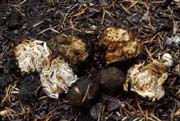
Steve Trudell |
- Humaria hemispherica (Wigg. ex Fr.) Fuckel
CUP 1-3 cm wide, 0.5-1.5 cm high, permanently cup-shaped, interior gray-whitish, outer surface and margin brown and covered with stiff pointed dark-brown hairs. STEM none. HABIT usually gregarious, but sometimes single. HABITAT on damp ground and on very rotten wet wood. DISTRIBUTION BC, WA, ID, AB, AK, CA and elsewhere. MICROSTRUCTURES spores 22.5-27 x 10-13 um, elliptic, with coarse warts, colorless, with two droplets; asci 8-spored, 230-270 x 19-23 um; paraphyses with clubshaped thickening up to 7-8 um wide at tips; hairs 200-531 x 14-21 um, (at margin up to 1000 um long), tapering evenly to point, thick-walled, multiseptate, dark brown, smooth.
- Tricharina gilva (Boud. in Cooke) Eckblad
CUP 0.2-0.5 cm wide cup, yellow orange when young, becoming fawn or light ocher, when old the margin bending outward; outer surface colored the same but covered with stiff light reddish brown hairs, appearing scurfy. STEM absent. HABITAT on bare and mossy burned ground. DISTRIBUTION at least OR, ID. MICROSTRUCTURES spores 14-16 x 9-10 um, elliptic, smooth; asci 8-spored, 170-190 x 14-16 um; paraphyses slender with tips slightly thickened to 4 um; hairs 150-190 x 3-5 um, with base up to 10 um, multiseptate, tips slightly rounded off.
- See Key to Morchellaceae, Pacific Northwest Key Council, in preparation
- See Key to Morchellaceae, Pacific Northwest Key Council, in preparation
- See Key to Helvellaceae, Pacific Northwest Key Council
- See Key to Club Fungi, Pacific Northwest Key Council
- Continue with this lead also for inoperculate cups, i.e. the phrase “asci with an operculum” may be ignored.
- See Key to Helvellaceae, Pacific Northwest Key Council
- See Key to Helvellaceae, Pacific Northwest Key Council
- U. hiemalis has not yet been recorded from Pacific Northwest, but Urnula padeniana is a more recent name for Sarcosoma mexicanum (see lead 17a), see also Key to Sarcosomataceae, Pacific Northwest Key Council
- See Key to Sarcosomataceae, Pacific Northwest Key Council. The two species this refers to, Sarcosoma mexicanum and Sarcosoma latahense, have more recently been known as Urnula padeniana and Pseudosarcoma latahense respectively.
- See Key to Sarcosomataceae, Pacific Northwest Key Council
- See Key to Sarcosomataceae, Pacific Northwest Key Council
- A number of inoperculate fungi will key out here but not fit either of the two leads following, including the following species that can reach over 5 mm across: Chlorociboria aeruginascens, Chlorociboria aeruginosa (both with blue-green colors on wood), Chlorencoelia versiformis (yellow-green colors on wood), Ciboria spp. (on cones, seeds, or catkins), Cudoniella clavus (on wet wood), Gloeotinia temulenta (on grass seeds), Monilia spp. (on mummified fruits and berries), Myriosclerotinia duriaeana (on sedge), Ovulinia perplexa (on vegetables), Sclerotinia juncigena (on Juncus), Stromatinia gladioli (on Gladiolus, Freesia, and Crocus), and Tatraea macrospora (dirty white or grayish discs on wood). For these species see Key to Cup Fungi, which describes the larger inoperculate species.
-
Pseudopithyella minuscula (Boud. & Torrend) Seaver
CUP 0.1-0.3 cm wide, nearly spherical becoming disc-shaped or almost so; scarlet; exterior whitish and tomentose. STEM slender, variable in length, often short < 0.1 cm. HABITAT on decaying foliage of Librocedrus decurrens (incense-cedar). DISTRIBUTION found OR, CA. MICROSTRUCTURES spores 15-17 x 10-11 um, elliptic, smooth, colorless, with two oil droplets; asci 8-spored, reaching 600 um length and 12-15 um width, with a thickened ring at the apex which gives it a "shouldered" appearance; paraphyses threadlike, branched, hardly enlarged toward tip, reaching diameter of 2 um at tip.
-
Microstoma protractum (Fr.) Kanouse
| CUP up to 2.0 cm wide, cup-shaped then the margin turned outwards, often lobed or torn; bright red; exterior orange, clothed with soft white hairs. STEM reaching 3-4 cm long and 0.1-0.2 cm wide, arising from a buried hard elongate black pseudorhiza which is usually attached to buried wood, the exposed part long, slender, often branched, with the lower half dark colored and the upper part whitish and downy with colorless hairs. HABIT and HABITAT clustered on buried wood. DISTRIBUTION at least CO, AB, photographed in WA by Drew Parker and in MT. MICROSTRUCTURES spores 24-45 x 10-14 um, elliptic-fusoid, with several oil droplets; asci up to 275 x 23 um; paraphyses slender, branched, only slightly enlarged at tips, with red contents that turn green in iodine; hairs reaching 6-7 um wide, about the same width throughout length, colorless, blunt. REMARKS 'stoma' is a neuter noun, hence 'protractum', although Kanouse did name it as M. protracta. | Microstoma protractum
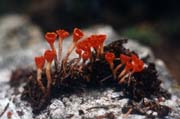
Andrew Parker |
-
Sarcoscypha coccinea (Jacq. ex Gray) Lambotte
| CUP 1-5 (8) cm wide, goblet-shaped then cup-shaped to saucer-shaped, circular to oval in outline from above; bright red; exterior whitish, with floccose to granular appearance from hairs. STEM short to very long (if deeply buried). HABIT and HABITAT single to gregarious on buried or fallen hardwood sticks and branches, often with moss, in spring. DISTRIBUTION at least BC, WA, OR, CA. MICROSTRUCTURES 24-32(40) um, elliptic, smooth, usually with a cluster of small oil droplets at each end; asci to 400 x 16 um; paraphyses slender, 3 um wide, not enlarged near tip, with red granular contents. | Sarcoscypha coccinea
.jpg)
Michael Wood (MykoWeb) |
-
Two of the Pacific Northwest species here have preferred names in Neottiella. If tiny, growing on burnt places among Funaria hygrometrica moss, see Neottiella hetieri; if larger, growing on sandy soil among Polytrichum and spores have distinct reticulation at 400x, see Neottiella rutilans. Note that the hairs of the former taper to a point when mature, rather than being blunt as in the key lead, and the hairs of the latter may also be considered pointed.
Neottiella hetieri Boud.
CUP tiny, up to 0.2 cm, becoming cup-shaped to platter-shaped to disc-shaped, bright orange-red, delicate white hairs fringing the margin and clothing the pale orange outside, the hairs not conspicuous. STEM none. HABITAT on burned places among Funaria hygrometrica, 1 or 2 years after the burn. DISTRIBUTION at least BC, also Europe. MICROSTRUCTURES spores 13-17 x 8-9 um, elliptic, smooth, with one large oil droplet, asci to 200 x 17 um, paraphyses up to 7 um wide at tip, slightly clavate with orange contents, hairs up to 200 x 15 um, blunt when young, tapering to a point when mature.
Neottiella rutilans (Fr.: Fr.) Dennis
CUP up to 1.5 cm, disc concave, reddish orange, margin scalloped and fringed with a few delicate hairs, exterior whitish or pale orange, clothed with wavy entangled downy hairs. STEM with a short stem reaching 0.5 cm, often buried in sand, sometimes without a stem. HABITAT growing on sandy soil among Polytrichum. DISTRIBUTION at least WA, CA, CO. MICROSTRUCTURES spores 22-31 x 13-15 um, broadly elliptic, sculptured with a network distinct at 400x, containing one or two large droplets, asci up to 300 x 20 um, paraphyses slight clavate reaching 6 um wide, with orange granules that turn green in iodine; hairs up to 300 x 12 um, colorless, septate, with rounded to pointed tip.
- Sowerbyella rhenana (Fuckel) J. Moravec is the current name.
| CUP up to 1.0-2.5 cm wide, shallowly broadly cup-shaped to nearly flat when old, bright orange to yellow-orange, margin incurved becoming straight to flaring when old; exterior pale orange to white, typically with inconspicuous colorless appressed hairs; flesh thin, brittle. STEM up to 0.5-3.0 cm in length and 0.2-0.5 cm in width, equal or narrowing downwards, often several stems together; colored as exterior; also with hairs. HABIT and HABITAT scattered to gregarious or cespitose in duff, usually under conifers. DISTRIBUTION at least WA, CA. MICRO-STRUCTURES spores 18-23.6(26.3) x 9-11.8 um, ornamented with a reticulum, the meshes 1.5 to 4 um broad and mostly 6-sided, ridges to 1.5 um tall, apiculus absent, guttulate; asci 8-spored; paraphyses curved or straight, containing orange granules, fleetingly green when mounted in Melzer's reagent. REMARKS a stemmed cup that is orange to yellow-orange with pale orange to white underside and stem, and guttulate reticulate spores that lack an apiculus. | Sowerbyella rhenana
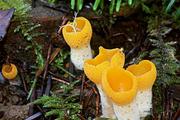
Boleslaw Kuznik |
- Two species are well-known. Geopyxis carbonaria is on burnt ground or wood and is red-brown to ocher-brown. Geopyxis vulcanalis typically grows in moss in coniferous woods and is pale orange to yellowish. It can grow on burned ground, but spores are somewhat larger, and it has more tendency to expand.
Geopyxis carbonaria (Alb. & Schw. ex Pers.) Sacc.
| CUP 0.5-1.5 (2.0) cm, goblet-shaped, (with mouth small in relation to cup size); red-brown to ocher-brown; smooth; margin white-scalloped to white-toothed; exterior same color as interior, somewhat lighter towards margin and dusted with white, minutely scurfy. ODOR some Geopyxis species have sulphur odor. STEM when present 0.5-2 x 0.1-0.15 cm slender, whitish to orange-brown, embedded in substrate. HABIT and HABITAT single to gregarious on burnt ground or attached to charred wood. DISTRIBUTION BC, WA, OR, ID. MICROSTRUCTURES spores (11)12-15(17) x 6.5-8(9) um, elliptic to slightly fusiform, smooth, colorless, without droplets; asci 8-spored, 180-210(310) x 10-11 um; paraphyses slender, septate, forked toward the base, tips with slight clavate thickenings, sometimes rather lobed with gnarled outgrowths. REMARKS Tarzetta species have spores with two oil droplets. | Geopyxis carbonaria
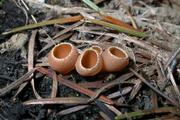
John Davis |
Geopyxis vulcanalis (Peck) Sacc.
| CUP 0.3-1 (2) cm wide, deeply cup-shaped, often flattening when old; pale orange to pale or dingy yellowish; margin usually finely scalloped; exterior paler than interior or whitish, usually pruinose when young but smooth when old. ODOR some Geopyxis species have sulphur odor. STEM usually present, up to 0.5 cm long and 0.1-0.3 cm wide, equal or narrowing downward, colored as exterior. HABIT and HABITAT scattered to densely gregarious under conifers, or in burned areas, fall, winter, and spring. DISTRIBUTION BC, WA, OR, ID. MICROSTRUCTURES spores 14-21 x 8-11 um, elliptic, with ends narrowed, smooth, without oil droplets; asci reaching a length of 275 um and a width of 15-17 um; paraphyses slightly thickened in upper part, reaching a width of 4 um at tip. | Geopyxis vulcanalis
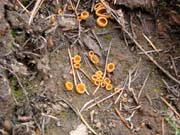
Ian Gibson
|
- Two species are described below. T. cupularis distinguished by somewhat wider spores, as well as generally smaller size, (Breitenbach following Dennis); T. cupularis may also be grayer (grayish ochraceous as opposed to cream to ochraceous), and lobed tips of paraphyses are not noted.
Tarzetta catinus (Holmsk.: Fr.) Korf & J.K. Rogers
| CUP 1-5 cm, remaining cup-shaped for a long time, sometimes becoming expanded and flat when old, or splitting into lobes; cream to pale yellowish brown, margin somewhat scalloped or toothed; exterior same color or somewhat lighter than upper surface; downy; flesh thin, brittle. ODOR and TASTE none. STEM if present usually embedded in ground and usually short and stout. HABIT and HABITAT single or in clusters, in forests, in gardens, on roadsides, or on soil. DISTRIBUTION WA, OR, CA, CO. MICROSTRUCTURES 20-24 x 11-13 um, elliptic, smooth, colorless, with 2 large droplets; asci 8-spored 280 x 16 um (about 350 x 20 um in a different source); paraphyses slender, septate, and branching in lower part, tips slightly thickened to 4 um or lobed. REMARKS Geopyxis vulcanalis is yellowish, does not have oil droplets in spores. | Tarzetta catinus
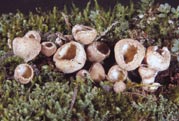
Kit Scates Barnhart |
Tarzetta cupularis (L. ex Fr.) Lambotte
CUP 0.5-1.5 (2.0) cm wide, remaining goblet-shaped to cup-shaped for a long time; gray-whitish to gray-yellow-brown; smooth; margin finely scalloped or toothed; exterior appears lighter due to its covering of fine, pale down. STEM indistinct to very distinct, buried in ground. HABIT and HABITAT single to gregarious on burned ground, damp soil, or moss in coniferous woods, or roadsides. DISTRIBUTION BC, WA, OR, ID. MICROSTRUCTURES spores 19-22 x 13-15 um, elliptic, smooth, colorless, with 2 large droplets; asci 8-spored, 310-280 x 15-16 um (about 300 x 15 in different source); paraphyses slender, septate, and branching at the base, tips slightly thickened.
- A number of of inoperculate fungi will key out here but not fit either of the two leads here. See 18.
- A few of the larger inoperculate cup fungi may reach 1-1.5 cm including Chlorencoelia versiformis, Monilia fructicola, Ciboria amentacea, and Tatraea macrospora (see 18)
- Gelatinodiscus flavidus (renamed Chloroscypha flavida) will not usually key out here, as it is more yellow than green, found near snow-banks on old yellow cedar foliage, but these may: Chlorencoelia versiformis (yellow green on wood), Chlorociboria aeruginascens, and Chlorociboria aeruginosa (both blue-green on wood). All four are described in Key to Cup Fungi, which includes descriptions of the larger inoperculate cup fungi.
- The current spelling has reverted to ‘deerrata’. Not included in Larsen-Denison checklist (1978) or Preliminary Checklist of North American Pezizales, but a WA collection by Harold Larsen is shown here (see 59a).
Pseudombrophila deerrata (Karst.) Seaver
| CUP 2-10 mm diam., convex to flat or shallow cup-shaped, wavy when old; reddish tan, purplish tan, orangish tan, gray with purplish or pinkish tint, light violet, or reddish, exterior similar color, dotted with somewhat darker scales (tufts of hairs). STEM short, and especially when young, the stem surrounded by dense white felty subiculum. HABIT and HABITAT growing gregariously on rotting remains of plants or soil beside such. MICROSTRUCTURES spores 12-16 x 7-9 um, elliptic, colorless, under oil immersion revealing an obliquely transverse sinuous structure when stained with cotton blue, without droplets or occasionally with central droplet; asci 8-spored, 150-160 x 10-11 um; paraphyses filiform and branched, uniformly about 2 um wide, septate, colorless or some with dark granular contents; excipulum with hair-like tufted hyphal outgrowths up to 120 um long and about 4-5 microns wide; subiculum hyphae 2-3 um wide, colorless, sometimes branched and with clavate thickenings at the end, septate. REMARKS Some authors correct the spelling to Pseudombrophila deerrata. | Pseudombrophila deerrata
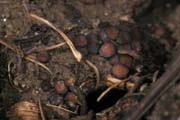
Harold Larsen |
- Wynnella silvicola (Beck) Nannfeldt
== Helvella silvicola (Beck) Harmaja Karstenia 14: 103. 1974; == Otidea silvicola Beck
| CUP up to 5 cm wide, 1-8 cm high, rabbit-ear-shaped or rarely irregularly cup-shaped with one enlarged lobe, margin inrolled at first, expanding; dark purplish red brown to dark brown fresh, blackish brown when dry, smooth; exterior medium red brown or pale red brown to white near base, bald. STEM up to 0.8 cm x 2.0 cm fresh, narrowing to base or nearly equal; yellow brown to pale yellow or white at base; shallowly fluted or ribbed or grooved. ODOR unique strong odor when dried, but not detected fresh. HABIT and HABITAT single to gregarious or scattered, under conifers, rarely in burned areas, June to September. DISTRIBUTION BC, WA, ID, AK, AB, CO. MICROSTRUCTURES spores 17-24 x 11.5-17 um, broadly elliptic, smooth, with one droplet; asci 200 x 15-19 um; paraphyses clavate, 5-6 um wide at apex, brown, contents finely granular. REMARKS Otidea smithii has smaller spores with two oil droplets. | Wynnella silvicola
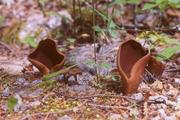
Andrew Parker |
-
There are at least 10 species of Otidea in the Pacific Northwest, described in detail below. Concepts follow Olariaga et al.(2015). Otidea alutacea group is common and distinguished from most of the other species by the truncate rather than rabbit-ear-shaped fruitbodies. Otidea oregonensis also has a truncate form, but is uncommon, with an interior that is grayish white to pale ocher, sometimes with pink stains, an exterior that is bright citrine yellow, and distinctly smaller spores. A third truncate species Otidea rainierensis is rare and has intermediate-sized spores: it was described in 1949 from dried material but has been found several times since. Consult the description for O. rainierensis if the paraphyses under the microscope are not hooked or bent at their tips and they are enlarged abruptly at the tips into an almost spherical head.
Apart from Otidea propinquata, a rare ocher-brown to red-brown stemmed cup, all the other known Otidea species in the Pacific Northwest have a rabbit ear shape. Otidea smithii has a deep purplish brown exterior, and is relatively large. Otidea onotica is common and is yellow to yellow-brown inside and out, often with a pinkish tinge in the interior. Otidea leporina is yellow-brown to brown inside and out, uncommon, seldom has pink stains, sometimes has a persistently narrow ear shape, and has wider spores. Otidea pseudoleporina and Otidea tuomikoskii are both uncommon and both have shorter spores than the three rabbit ear shaped species so far mentioned. O. pseudoleporina is ocher orange to pinkish orange inside and yellow-brown outside which is scurfy to finely warty, whereas O. tuomikoskii is pale ocher to ocher yellow, with rare pink stains, on the inside; yellow-brown and more distinctly warty on the outside; and persistently narrowly ear-shaped. Finally the rare Otidea nannfeldtii is also persistently narrowly ear-shaped. Spores are slightly shorter than with O. tuomikoskii (and O. pseudoleporina) but overlapping. The inside is orange ocher to pale brown, sometimes with pink tones. The outside is orange ocher to pale brown and warty. Additional features distinguishing O. nannfeldtii and O. tuomikoskii are given in the description of the latter below.
Otidea alutacea (Pers.) Massee group
| FRUITBODY 2-4 cm across, 1-6 cm high, more or less cup-shaped but with the shorter side split lengthwise or open, semierect, but often distorted by growing in clusters, apex often truncate; interior tan, light brown, dingy yellowish brown or grayish brown; exterior colored similarly to interior. STEM if present a short narrowed whitish downy extension. HABIT and HABITAT scattered to densely clustered in humus, under conifers or hardwoods, summer, fall, often along roadsides, summer to winter. DISTRIBUTION WA, ID, AB, CA according to Larsen & Denison list, common in the Pacific Northwest. MICROSTRUCTURES spores 14-16 x 7-9 um (Kanouse, Arora), 15-18 x 7-8 um (Olariaga et al. for clade 2), narrowly elliptic, smooth, with 2 droplets, (Kanouse), asci 150-300 x 8-15 um (including European descriptions); paraphyses filiform, occasionally branched below one or two times, septate, colorless, apices hooked, (Kanouse who does not mention any enlargement at tips). REMARKS More work is needed before the different clades within this group can be assigned independent species names. O. oregonensis (uncommon) and O. rainierensis (rare) also have a truncated rabbit ear shape, but have smaller spores and swollen ends on the paraphyses. The former is bright citrine yellow on the exterior. | Otidea alutacea group
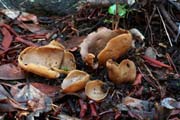
A and O Ceska |
Otidea leporina (Fr.) Fuckel
FRUITBODY 0.4-2.5 cm across, 1.7-5.2 cm tall, rabbit ear shaped, often expanding to broadly ear-shaped, split to base on short side; interior yellow-brown to more dingy brown or orange-brown, seldom with pale pink stains; exterior similar in color, yellow-brown, no pink stains, furfuraceous or finely warty, warts conic to flattened, sometimes darker than background. STEM up to 1.5 cm long when present. HABIT and HABITAT single to clustered in conifer forests. DISTRIBUTION found WA, OR, (Olariaga et al.), BC, WA, OR, ID, (Larsen-Denison list). MICROSTRUCTURES spores (12)12.5-14(15 x 7-8.5 um, elliptic, smooth, with 2 droplets; asci 170-215 x 9-10.5 um; paraphyses threadlike, curved to hooked at tips which are slightly thickened, with small light yellow droplets. REMARKS O. onotica has pinkish cast on inner surface when young, and narrower spores; O. smithii has purple-brown outer surface; other rabbit ear shaped spp. in the Pacific Northwest have smaller spores. O. alutacea is truncate, usually has grayish brown inner surface and usually grows in dense clusters.
Otidea nannfeldtii Harmaja
FRUITBODY 0.5-1.5 cm across, 0.8-3.5 cm tall, narrowly rabbit ear shaped, sometimes expanding and becoming broadly ear-shaped, split; interior ocher, orangish ocher or pale brown, sometimes with pink tones; exterior brown orange to pale brown, finely warty, smooth at the base, warts conic, sometimes distinctly darker than the background. STEM 0.4-0.8 cm x 0.2-0.3 cm if present. HABIT and HABITAT gregarious to cespitose under conifers; fruiting in September, October, and December in collections examined by Olariaga et al. DISTRIBUTION includes OR. MICROSTRUCTURES spores (9)9.5-10.5(11.5) x 5.5-6.5(7) um, elliptic, smooth, with two large droplets; asci 137-190 x 8-10 um; paraphyses curved to hooked, may be slightly broader at apices, 2.5-5 um wide, without notches, rarely forked at apices, when fresh containing small, light yellow droplets; warts 45-85 um high; excipulum (exterior layer) does not turn yellow with KOH under the microscope; resinous exudates abundant, yellow brown, reddish brown in KOH. REMARKS O. tuomikoskii is similar, see that species for differences. O. pseudoleporina has an ocher-orange to pinkish orange interior, narrowly to broadly ear-shaped young fruitbodies, and resinous exudates on the exterior that dissolve partially to entirely into reddish gray heterogeneous drops in KOH. O. nannfeldtii "is characterised by ochre to light brown, narrowly ear-shaped apothecia, small spores and resinous exudates on the ectal excipulum turning reddish brown in KOH", (Olariaga et al.). Other ear-shaped species in the Pacific Northwest have larger spores.
Otidea onotica (Pers.) Fuckel
| FRUITBODY 1-6 cm wide, (wider when expanded), 3-10 cm tall, usually shaped like the bowl of a spoon or like a rabbit ear (erect with one side open or split), margin inrolled at first; interior yellow-brown to dull orange to orange-buff or pale yellowish, often with a pinkish or rosy tint when fresh, smooth; exterior colored more or less as interior but without pinkish tinge; slightly warty. STEM whitish, narrowed. HABIT and HABITAT scattered or more often in groups or clusters under both hardwoods and conifers, especially Pseudotsuga menziesii (Douglas-fir), fall and winter. DISTRIBUTION WA, OR, ID, according to Larsen-Denison list, BC according to Redhead list, common in the Pacific Northwest. MICROSTRUCTURES spores (11)12-13.5(14) x (5.5)6-7 um, elliptic, smooth, colorless or faintly yellowish, with 2 large droplets, obliquely 1-seriate; asci 8-spored, 138-233 x 9.5-12 um; paraphyses thread-like (may be slightly broader at apices) with light yellow droplets when fresh, curved to hooked, frequently forked in lower part. REMARKS O. leporina is smaller, less orange colored, and usually lacks pinkish tinges, and spores are wider. O. smithii has a purplish brown exterior. Other rabbit ear shaped spp. In the Pacific Northwest are uncommon or rare and have smaller spores. O. alutacea is truncate and usually has a grayish brown inner surface. | Otidea onotica
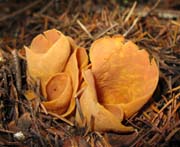
Michael Beug |
Otidea oregonensis K. Hansen & Olariaga
FRUITBODY 2.3-8.0 cm across, 1.2-4.8 cm tall, shallowly to deeply cup-shaped, sometimes elongated on one side or obconic, usually split; interior grayish white to pale ocher, sometimes with pinkish stains or spots; exterior bright citrine yellow, fading to brownish ocher when old, furfuraceous, flat concolorous warts sometimes present toward base. STEM 0.3-1.8cm x 0.3-1.1cm when present. HABIT and HABITAT gregarious to cespitose [tufted], under conifers (for examined collections where habitat mentioned), October to December for examined collections. DISTRIBUTION includes OR and WA. MICROSCOPIC spores 10-11.5 x 5.5-6(6.5) um, elliptic, smooth, with two large droplets, rarely with a few small granules; asci 171-203 x 9-10.5 um; paraphyses bent to curved or sometimes straight, subclaviform to capitate at apices, 3-6(8) um wide, without notches, warts 35-70 um high; resinous exudates on external surface often abundant, yellow, brighter yellow in KOH. REMARKS O. alutacea group is more common, the exterior is light brown, grayish brown, or dingy yellowish brown, and spores are larger. O. rainierensis has some similarities (see REMARKS for that species).
Otidea propinquata (P. Karst.) Harmaja
FRUITBODY 1.5-3.5 cm across, 0.7-2.0 cm tall, obconic to broadly cup-shaped, very rarely split, margin sometimes wavy; interior ocher brown to dark reddish brown; exterior "concolorous", orange-brown, furfuraceous to warty, warts hemispheric to conic, the same color as background or darker brown. STEM 0.7-1.6 cm x 0.2-0.7 cm. HABIT and HABITAT gregarious or cespitose, under conifers, August to October in collections examined by Olariaga et al. DISTRIBUTION includes WA. MICROSTRUCTURES spores (18)19-21 x 10-12.5 um, elliptic, smooth, with 2 larger and several smaller droplets; asci 231-275 x 12-16 um; paraphyses hooked, often enlarged at apices, 3-5 um wide, may be forked at apex, when fresh containing small, refractive, light yellow droplets; warts 50-75 um high; external surface with abundant yellow-brown to resinous exudates that turn brownish red in KOH. REMARKS Otidea propinquata is unlike other Otidea species in the Pacific Northwest in its stemmed cup fruitbody without a split in the side. Occasionally a split can be lacking in individual fruitbodies of other spp.
Otidea pseudoleporina Olariaga & K. Hansen
FRUITBODY 0.8-2.2(3.1) cm across, 1.0-3.0(5.0) cm tall, initially narrowly to broadly ear-shaped, expanding and sometimes becoming irregularly cup-shaped, split; interior ocher-orange to pinkish orange, sometimes with pink spots or stains; exterior ocher-brown, furfuraceous to finely warty, sometimes wrinkled at base, warts conic to rounded, colored as surface or reddish brown. STEM 0.4-1.1 cm x 0.3-0.5 cm when present. HABIT and HABITAT gregarious under conifers, fruiting in fall but sometimes at other times of year. DISTRIBUTION includes WA, OR, ID, CA. MICROSTRUCTURES spores (9.5)10-12(12.5) x 5.5-6.5 um, elliptic, smooth, with 2 large droplets, sometimes with up to 4 smaller droplets; asci 155-231 x 9-10 um; paraphyses curved to hooked, may be slightly enlarged at apices, 2.5-4.5 um wide, sometimes with 1-3 notches; warts 77-115 um high, broadly conic; resinous exudates abundant, yellow-brown, partially to completely dissolving into reddish gray droplets in KOH. REMARKS O. leporina differs in the brown fruitbodies and larger, broadly elliptic spores. O. nannfeldtii has the same general shape and small spores but has narrowly ear-shaped young fruitbodies, most often lacking orange tones, and ectal excipular resinous exudates turn reddish brown in KOH. See also REMARKS under O. tuomikoskii. O. onotica and O. smithii have different coloring and larger spores among other differences.
Otidea rainierensis Kanouse
FRUITBODY 3-7 cm high, nearly as wide as high, split to the base, edges inrolled; interior "avellaneous," "vinaceous buff" to "drab gray" (dry), creamy white toward base; exterior "ochraceous buff", "cinnamon buff" to "wood brown" (dry) (colors from Ridgway); fresh color probably has some yellowish or ochraceous tones. STEM up to 1 cm long, tending to be hollow. HABIT and HABITAT single to gregarious on humus in woods. DISTRIBUTION described from a dried collection in WA (Kanouse) and found several times since (according to Nancy Smith-Weber, pers. comm.) MICROSTRUCTURES spores 10-12 x 6-7(8) um (Kanouse), 11-12 x 6.5-7 (Olariaga et al.), elliptic, smooth, faintly yellowish, with 2 droplets; asci 140-160 x 10 um, cylindric, frequently with a long slender stemlike base; paraphyses threadlike, colorless, septate, abruptly thickened at tips into broadly clavate, pear-shaped, nearly spherical to spherical heads 6-8(10) um wide. REMARKS The relatively large size and the straight paraphyses with an abruptly enlarged, broadly clavate to spherical head are the characteristic features of this rare species. In O. oregonensis paraphyses are described as “bent to curved, sometimes straight, subclaviform to capitate at apices”, 3-6(8) um wide, (Olariaga et al.). Spores for O. oregonensis are measured by Olariaga et al. at 10-11.5 x 5.5-6(6.5) um.
Otidea smithii Kanouse
| FRUITBODY 1.3-4 cm across, 3-9 cm tall, typically taller than broad; rabbit ear shaped, split on one side, interior brown to deep purple-brown when fresh, exterior somewhat darker purple-brown, warts conic, obtuse or acute, sometimes slightly darker than background. STEM 1.2-2.6 cm x 0.5-1.2 cm. HABIT and HABITAT single to gregarious in various habitats, fall and winter. DISTRIBUTION BC, WA, OR, CA, (Olariaga et al.), also ID according to Larsen-Denison list. MICROSTRUCTURES spores 12-14(14.5) x 6-7.5 um, elliptic or fusoid, smooth, colorless or faintly yellowish, with 2 droplets; asci 8-spored, 175-250 x 9-11 um; paraphyses colorless, with hooked or bent tips, width the same or slightly larger at apices. REMARKS Wynnella silvicola is somewhat similar but has larger spores with one large droplet. Other Otidea species have different coloring. | Otidea smithii
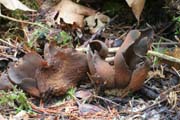
A and O Ceska |
Otidea tuomikoskii Harmaja
FRUITBODY 0.7-3.0 cm across, 1.7-6.0 cm tall, narrowly rabbit ear shaped, split, interior pale whitish ocher to ocher yellow, rarely with pink stains; exterior brownish ocher to yellow-brown, conic warts brown, darker than background or rarely lighter. STEM 0.3-0.6 cm x 0.2-0.3 cm when present. HABIT and HABITAT gregarious to cespitose, most often among needle litter or even on very decayed wood, in coniferous forests, fruiting August to December in collections examined by Olariaga et al. DISTRIBUTION includes WA, OR, and CA. MICROSTRUCTURES spores (9.5)10-11(12) x 5.5-6.5(7) um, elliptic, smooth, with two large droplets and sometimes with 1-4 smaller granules; asci 113-199 x 9-11.5 um; paraphyses curved to hooked, often broader at apices, 2.5-5(6) um, sometimes with up to two shallow notches or forked at apices, when fresh with small to large, refractive, colorless to pale yellow droplets; conic warts 55-177 um high; resinous exudates abundant, yellow-orange to yellowish brown, unchanged in KOH; excipulum turns yellow in KOH under microscope (sometimes weak) and this reaction can be observed macroscopically in fresh fruitbodies. REMARKS Otidea tuomikoskii is characterized by the narrowly ear-shaped fruitbody, with high warts on the outside, small spores, and the outer layer almost always turning yellow in KOH. Only O. pseudoleporina and O. nannfeldtii among ear-shaped spp. in the Pacific Northwest have spores as small. O. pseudoleporina has an ocher-orange to pinkish orange interior, narrowly to broadly ear-shaped young fruitbodies, and resinous exudates on the exterior that dissolve partially to entirely into reddish gray heterogeneous drops in KOH. O. nannfeldtii is probably the closest species in appearance. According to Olariaga et al. 1) warts are lower (45-85 um high) and less dense on the exterior of O. nannfeldtii than on the exterior of O. tuomikoskii which has warts 55-177 um high. 2) O. nannfeldtii lacks orange tones in basal tomentum which is white to light yellow or ocher whereas O. tuomikoskii has orange ocher to light ocher basal tomentum. 3) The hymenium sometimes has pink tones or is entirely pinkish in O. nannfeldtii. Pink stains do occur rarely in O. tuomikoskii. 4) The paraphyses of O. nannfeldtii do not have shallow notches (rarely they do have slightly swollen areas). 5) In O. nannfeldtii the excipulum (exterior layer) does not turn yellow with KOH under the microscope. 6) Resinous exudates on the surface cells of the exterior of O. nannfeldtii are yellow-brown and turn reddish brown in KOH, whereas resinous exudates on surface cells of the exterior of O. tuomikoskii are yellow orange to yellow-brown and the color does not change in KOH. (Olariaga et al.)
-
This taxon has been placed in the genera Peziza, Aleuria, and Discina at different times. Its place in the key here depends on its occurrence without a split in the side, but it does also occur with a split in the side (see footnote immediately above). Kanouse examined material from WA, MT, and CO, but its rarity in the Pacific Northwest is indicated by the fact that neither Harold Larsen not William Denison had been able to confirm its presence west of the Great Plains by the time they wrote the Larsen-Denison list in 1978.
- It seems this should read choice 29.
- See Key to Pezizaceae, Pacific Northwest Key Council
- See Key to Helvellaceae, Pacific Northwest Key Council
- See Key to Helvellaceae, Pacific Northwest Key Council
- Disciotis venosa (Pers. ex Fr.) Boud.
| CUP (3) 5-20 (31) cm wide, cup-shaped, usually flattening; light to dark brown, reddish brown or yellowish brown; smooth usually becoming at least at the center radially wrinkled or veined or with a network, or pebbled; margin light colored, often wavy and split; exterior whitish to buff or ocher, scurfy, rough, or minutely warty, often ribbed or wrinkled at the base; flesh 0.3-1.0 cm thick, fragile and fruitbody often hard to collect intact. ODOR mildly to strongly bleachlike, at least in Europe. TASTE mild. STEM when present 0.5-1.0 cm in length, thick, and usually buried and fused with ground. HABIT and HABITAT single, scattered or in small groups in damp or mossy soil or humus under or near trees or occasionally in the open, mainly in spring. DISTRIBUTION at least OR, ID, CA, CO, NM, UT. MICROSTRUCTURES spores 19-31(30) x 12-15(17) um, broadly elliptic, smooth, without large oil droplets, sometimes with small droplets on both ends outside the spore wall; asci 8-spored, 300-350 x 17-23 um; paraphyses septate, some of them branching near base, with clavate thickenings at the ends to 8-12 um wide and with brownish contents. REMARKS Discina perlata is less cuplike, less veined, and has warted spores that have three oil droplets. Peziza species have thinner flesh and ascus layer turns blue if a drop of iodine solution placed on it. | Disciotis venosa
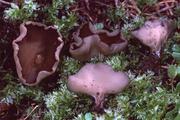
Michael Beug |
-
Rhizina undulata Fr.:Fr.
| FRUITBODY 2-10 cm wide, disc-shaped to convex and reflexed, sometimes fused with adjacent fruitbodies; medium to dark red-brown fresh to blackish brown dried, undulating and wrinkled, typically with a distinct white to yellow or yellow brown marginal zone; underside white to pallid brown, downy, with several to many white, yellow or pallid gray brown forked rhizoid-like projections, up to 3 cm long, to which plant remains adhere; flesh light brownish, fragile, spongy, when old tough. STEM none. HABIT and HABITAT single to gregarious on soil, duff or woody debris, typically in recently burned areas under conifers, March to November. DISTRIBUTION BC, WA, OR, ID. MICROSTRUCTURES spores 30-45 x 8-15 um, narrowly fusoidal (spindle-shaped), finely warty to rough, sometimes connected transversely to form ridges, colorless, with 2 to 4 droplets, colorless pointed appendages on both ends 3-5 um long; asci 375-450 x 12.4-19.9 um, spores in part 2-seriate; paraphyses clavate, 5.4-7.9 um wide at tip, colorless, with brown encrusted pigment, contents finely granular; setae 6.6-8.1 um in lower part, widening gradually to 8.8-10.9 um at blunt tip, sometimes lobed, brown, aseptate, reaching to the surface of the hymenium. | Rhizina undulata
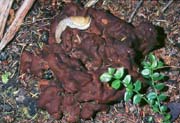
Ben Woo |
-
Pseudocollema cartilagineum Kanouse & Smith was renamed Byssonectria cartilaginea (Kanouse et Smith) D. Pfister. See also 78b.
-
Pyronema omphalodes (Bull. ex St.-Amans) Fuckel, given by Hansen et al. as a synonym of Pyronema confluens (Pers.) Tul. & C. Tul. is a Pacific Northwest representative of this genus. Pyronema domesticum (Sowerby) Sacc. has also been reported.
Pyronema omphalodes (Bull. ex St.-Amans) Fuckel
| FRUITBODY small, usually not over 0.1-0.2 cm, cushion-shaped (convex), pale orange (slightly yellowish to bright orange, sometimes with a purplish tinge), seated on a dense white superficial mycelium; underside bald. STEM none. HABIT and HABITAT densely gregarious, often becoming confluent, forming masses several cm in diameter, on burned places, in greenhouses on steamed soil or soil that has been sterilized by dry heat. DISTRIBUTION at least BC, WA, ID, AB, CA, UT. MICROSTRUCTURES spores 10-13 um x 5-8 um, elliptical, smooth, colorless, 1-seriate, without oil droplets; asci 8-spored, 150 x 10-14 um, not blued by iodine; paraphyses simple, rather stout, very slightly enlarged at tips, reaching a diameter there of 6-7 um, filled with orange granules. REMARKS Pyronema domesticum appears similar. It differs especially by larger spores 15-20 x 10-12 um. The exterior has hairs especially near the margin. Its color tends toward salmon-pink (but varies from orange-red to smoked-salmon-color). | Pyronema omphalodes
.jpg)
Michael Wood (MykoWeb) |
- See Key to Sarcosomataceae, Pacific Northwest Key Council. The two species this refers to, Sarcosoma mexicanum and Sarcosoma latahense, have more recently been known as Urnula padeniana and Pseudosarcoma latahense respectively.
- U. hiemalis has not yet been recorded from Pacific Northwest, but Urnula padeniana is a more recent name for Sarcosoma mexicanum (see lead 17a), see also Key to Sarcosomataceae, Pacific Northwest Key Council
- See Key to Pezizaceae, Pacific Northwest Key Council
- Not recorded from Northwest, see Key to Sarcosomataceae. Nannfeldtiella has been absorbed into Pseudombrophila.
- See Key to Sarcosomataceae, Pacific Northwest Key Council
- See Key to Sarcosomataceae, Pacific Northwest Key Council
- See Key to Sarcosomataceae, Pacific Northwest Key Council
- See 6a
-
Encoelia furfuracea, an inoperculate cup fungus in Heliotales could key out here, growing on alder or hazel in spring. It is up to 1.5 cm across, closed and bladder-like when young, then splitting open apically more or less in the form of a star and becoming irregularly cup-shaped to saucer-shaped (the margin often incurved), cinnamon-brown to dark brown or light brown, drying black, underside covered with whitish to rust-colored mealy flakes that can be wiped off. There is further description in the Key to Cup Fungi.
- See Key to Sarcosomataceae, Pacific Northwest Key Council
- There are at least 2 species of Trichophaea in the Pacific Northwest. Besides those two, Trichophaea boudieri Grélet (according to some a synonym of Paratrichophaea boudieri (Grélet) Bronkers), was reported from Idaho, Trichophaea bullata Kanouse was reported from WA and OR, and Trichophaea gregaria (Rehm) Boud. was reported from Oregon, but all require confirmation. (See Breitenbach & Kränzlin, and Kanouse (1958) for descriptions of those species.)
Trichophaea abundans (Karst.) Boud.
CUP 0.1-0.5 cm wide, top-shaped to disc-shaped, dark grayish brown to light grayish brown or grayish white; margin fringed with short pale downy hairs; underside with hairs longer than those at margin; colored as interior in lower part, grayish white at the distinct margin. STEM none. HABITAT on peat moss on burned soil very soon after the burning, on charred wood, on sterilized soil in a greenhouse; spring and fall. DISTRIBUTION found OR, ID, also CA, CO. MICROSTRUCTURES spores 11-15 x 6-8 um, elliptic, ends narrowed, smooth, faintly yellow, with central droplet (according to Kanouse, but Hansen et al. and Dennis both say 2 droplets), 1-seriate with ends overlapping; asci 8-spored, 120-160 x 8-11 um, inamyloid; paraphyses filiform (threadlike), colorless, tip slightly clavate, 6-7 um wide; marginal hairs 40-60 x 8 um, dilute brown to colorless, darker in lower part, thin-walled, 1-5-septate, tip pointed, arising from bulbose cells up to 16 um wide, hairs below the margin long 80-310 x 6 um, scattered, pale to dark brown, sparingly septate, even in width throughout, tip pointed or blunt.
Trichophaea hemisphaerioides (Mont.) Graddon
CUP 0.5-1.0 (1.5) cm wide, at first hemispherical, then remaining cup-shaped for a long time and later flat, the fringed margin always remaining turned upward; white to gray-whitish, sometimes with bluish tint; margin and underside with brown hairs. STEM none. HABITAT single to gregarious on burned ground, commonly among the burned-ground moss (Funaria stage of succession) and on burned pieces of wood, April-October. DISTRIBUTION at least OR. MICROSTRUCTURES spores 13-18 x 5-7 um, narrowly elliptic, some finely punctate and rough, colorless, with 2 droplets; asci 8-spored, 175-200 x 7-8 um; paraphyses slender, forked at base, septate, tip slightly thickened; hairs 200-400 x 10-17 um, dark brown, thick-walled, multiseptate, narrowing to a point. REMARKS description derived from Breitenbach & Kränzlin.
- See 7b.
- See 7a.
- See 7b.
- At least the following species of Scutellinia occur in the Pacific Northwest: S. crucipila (Cooke & Phillips) J. Moravec, S. erinaceus (Schw.) Kuntze, S. scutellata (L. ex. Fr.) Lambotte, S. umbrarum (Fr.) Lambotte, and S. verrucipolaris Denison. Scutellinia scutellata is the most common, with orange to red color, growth on wood, bark or less often soil, spores (15)17-19(23) x (9)11-14(17) um that have warts barely visible with light microscope, and abundant to scattered rooting hairs (100)200-700(1300) um long (at least some over 1000 um). Scutellinia crucipila has bright orange to orange-red color, habitat on soil, spores 13-20 x 7-10 um that show warts only under oil immersion, and abundant hairs of two types, the marginal ones unbranched 100-200(500) um long, and the ones lower down mostly stellately branched. Scutellinia erinaceus has orange to yellow color, wood habitat, smooth spores 14-26 x 9-15 um, and short hairs 150-600 um long. Scutellinia umbrarum has orange to red color, habitat on soil or trash, less often on rotten wood, spores (19)20-24(26) x (12)14-16(18) um, with distinct rounded warts 0.5-1.5 um wide and high that are spread evenly over spore, and rooting hairs (75)150-700(900) um long. Scutellinia verrucipolaris has red color, habitat on soil and occasionally wood, spores 17-24 x 7.5-11 um, with distinct rounded to somewhat truncate warts 1 um wide and high, primarily seen at poles of spore, and rooting hairs 100-400(500) um long.
Scutellinia crucipila (Cooke et Phill. in Cooke) J. Moravec
== Cheilymenia crucipila (Cooke & Phillips) LeGal
CUP 0.1-0.4 cm, saucer-shaped to disc-shaped, bright orange to orange-red, fading slightly on drying; underside hairs abundant, of two types, the marginal ones unbranched, those lower down mostly stellately branched. STEM none. HABIT and HABITAT scattered on soil. DISTRIBUTION WA. MICROSTRUCTURES spores (13)15-18(20) x (7)8-9(10) um, elliptic, appearing smooth at low magnification, but with fine warts under oil immersion, without oil droplets; asci 180-220 um long, cylindric; paraphyses slender, 2-3 um wide with subclavate apices 4-7 um wide; marginal hairs unbranched 100-200(500) x 8-13 um, 2-5-septate, tapering upward to pointed or rounded tip, rooting in the medullary excipulum but with a single root, the lower ones "similar but mostly stellately branched, with 2-5 divergent arms 75-150 um long". REMARKS The fungus described as Humaria crucipila (Cke. & Phil.) Kanouse differs in color (pale ochre yellow) and growth on sticks, and could be a new species.
Scutellinia erinaceus (Schw.) Kuntze
| CUP 0.2-0.3 (0.4) cm, disc-shaped to slightly concave; dull orange with overtones of yellow or brown rather than red, fading to whitish on drying; exterior densely clothed with hairs. STEM none. HABIT and HABITAT intensely gregarious, but rarely so crowded as to be distorted by mutual pressure, on well rotted deciduous wood, July to December. DISTRIBUTION ID (Larson), WA (Kanouse). MICROSTRUCTURES spores (14)17-21(26) x (9)11.5(15) um, average length to width ratio 1.7, long elliptic, smooth, cytoplasmic granules sometimes giving the illusion of very fine markings under an oil-immersion objective; asci 8-spored, 270-331 x 12-15 um; paraphyses clavate or subclavate, 2-5 um wide at top, filled with orange granules when fresh; rooting hairs (with rootlets at base) abundant, (100)400-600(700) um long and (20)28(40) um wide at base, inconspicuously septate, dark brown, pointed at tip, or rarely blunt or with a constriction, many collections having some hairs that are distinctly crooked or that have short prong-like lateral branchlets; superficial hairs lacking or very inconspicuous. REMARKS The description is largely derived from Denison. "erinaceus" is a noun, so does not agree grammatically with "Scutellinia". Scutellinia scutellata is redder, has some longer hairs, and has broader spores with barely visible warts. | Scutellinia erinaceus
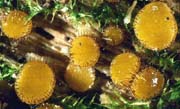
George Barron |
Scutellinia scutellata (L. ex. Fr.) Lambotte
| CUP 0.2-1.2 cm wide, cup-shaped becoming shallowly concave or disc-shaped; orange to red, rarely paler with pinkish or salmon cast; margin thickly fringed with dark brown bristle-like hairs; underside light brown, clothed with stiff dark brown or blackish hairs; flesh thin. STEM none. HABIT and HABITAT scattered to gregarious on rotten wood, bark, or soil, or less often on other substrates such as wood ashes, decaying leaves, and rotting Fomes fruitbodies. DISTRIBUTION BC, WA, OR, ID. MICROSTRUCTURES spores (15)17-19(23) x (9)11-14(17) um, average length to width ratio 1.5, "sculpturing small, 0.1-1.0 um broad, freely anastomosing warts, not visible in optical section", containing one or more droplets; asci 8-spored, 240-320 x 15-20 um; paraphyses subcylindric to narrowly clavate, 3-5 um wide in lower part, 5-9 um wide in upper part, simple or rarely branched in lower part; rooting hairs abundant to scattered (100)200-700(1300) um long, "the longest ones concentrated at the margin, 2-12-septate, dark brown, pointed, straight or slightly curved at the base, not abruptly crooked, simple; superficial hairs usually present", (Denison), sap of paraphyses green in iodine, (Dennis). REMARKS S. umbrarum has larger spores with distinct rounded warts evenly spread over spore; S. verrucipolaris has spores with warts concentrated at poles; S. crucipila has hairs of two types (unbranched and stellately branched); S. erinaceus has orange to yellow color, smooth spores, and short hairs. The hairs with rootlets are shared by Cheilymenia species, but the spores of Cheilymenia species are smooth and without oil droplets, and generally they grow on dung. Melastiza chateri is a little larger, with less dense smaller hairs of a different structure, and spores with a conspicuous network; under a hand lens, the hairs of S. scutellata are stiff, brown, and bristle-like, whereas the hairs of M. chateri can be seen as soft, shorter, brown, and matted together, giving a streaky rather than spiny appearance. | Scutellinia scutellata
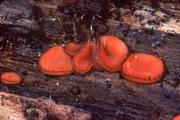
Michael Beug |
Scutellinia umbrarum (Fr.) Lambotte
CUP 0.8-2.0 cm, shallow cup-shaped to disc-shaped; thick fringe of dark brown bristle-like hairs on margin; underside appearing dark brown with dark brown bristle-like hairs. STEM none. HABITAT scattered to single on soil, plant debris, or trash, rarely on fragments of rotten wood embedded in moist soil, May to November. DISTRIBUTION BC, ID, CA, CO, and elsewhere. MICROSTRUCTURES spores (19)20-24(26) x (12)14-16(18) um, average length to width ratio 1.4, with distinct rounded warts 0.5-1.5 um wide and high, scattered over surface, mature spores with one, less often two droplets; asci 8-spored, 240-320 x 15-20 um; paraphyses almost cylindric to narrowly clavate, 3.5 um wide in lower part, 5-9 um wide near tip, simple or rarely branched in lower part; rooting hairs abundant, rather short (75)150-700(900), 2-8-septate, dark brown, pointed, base with simple to forked roots; superficial hairs absent or inconspicuous, when present often heavy walled, stout, and very short. REMARKS "umbrorum" is a mistaken masculine plural genitive, used instead of the correct feminine ending "umbrarum". S. scutellata has smaller smoother spores and longer hairs; S. verrucipolaris has narrower spores with the warts concentrated at the ends.
Scutellinia verrucipolaris Denison
CUP 0.2-0.8 cm, concave; "scarlet" to "grenadine red"; on underside, rooting hairs moderately abundant, superficial hairs also present, especially abundant toward base. STEM none. HABIT and HABITAT gregarious on soil and occasionally wood. DISTRIBUTION includes WA (Larsen and Denison list). MICROSTRUCTURES spores (7.5)9-11 x (17)19-22(24) um, average length to width ratio 2.0, with discrete rounded or subtruncate warts reaching a height and width of 1 um, "the largest warts most numerous toward the poles, in the equatorial region most of the warts much smaller, 0.15-0.5 um broad, and barely visible in optical section", two droplets present in spores; asci 8-spored, 240-300 um long; paraphyses 2-3 um wide at base, enlarging to 6-9 um just below tip, narrowly clavate to subfusiform; rooting hairs [with rootlets at base] 100-400(500) um long, septate, dark brown, pointed, a few bent or crooked; superficial hairs colorless, 2-3-septate. REMARKS description derived from Denison. Scutellinia umbrarum also has red color and warts on spores, but has warts evenly distributed on spores which are wider.
- Pacific Northwest species include Cheilymenia coprinaria (Cooke) Boud. (synonymized by some with Cheilymenia fimicola (Bagl.) Dennis, C. stercorea (Pers. ex Fr.) Boud., and C. theleboloides (Alb. & Schw. ex Fr.) Boud. All occur on dung, and the last occurs also on rich soil, decaying plant debris, rubbish, paper, cloth, or lime waste. Even that species rarely exceeds 0.5 cm, and it is the only one described here. See monograph by Denison(1964) for the others. Cheilymenia crucipila (Cooke & Phillips) Le Gal is a synonym of Scutellinia crucipila (Cooke & Phillips) J. Moravec.
Cheilymenia theleboloides (Alb. & Schw. ex Fr.) Boud.
CUP 0.2-0.5 (1.0) cm, saucer-shaped to disc-shaped; golden yellow or egg-yellow, becoming reddish brown in drying; exterior paler than spore-bearing surface, comparatively few hairs, colorless to yellowish-brown, the longest ones at the margin. STEM none. HABIT and HABITAT gregarious to crowded on dung, rich soil, decaying plant debris, rubbish, paper, cloth, or lime waste. DISTRIBUTION WA, OR, ID, elsewhere. MICROSTRUCTURES spores (15)17-20(22) x (7)8-10(11) um, (Dennis gives 12-18 x 7-10 um), elliptic, smooth, without oil droplets; asci 180-220 x 10-15 um; paraphyses slender, 3-4 um wide, infrequently septate, somewhat clavate at tips, 5-7 um wide; the longest hairs at the margin 170-800 um long, 8-10 um wide just above base, narrowing slightly, base often swollen to 15-31 um wide, 1-4(6) septate, straight, unbranched, usually with blunt tip.
- At least two species occur in the Pacific Northwest: Anthracobia melaloma has a somewhat yellowish ochraceous shade of orange color, hairs are multiseptate, and paraphyses stain green in Melzer's, whereas Anthracobia macrocystis has more reddish shade of orange color, hairs are mostly 1-celled, and paraphyses do not stain green in Melzer's.
Anthracobia melaloma (Alb. & Schw. ex Fr.) Boud.
CUP 0.1-0.3 (1.2) cm wide, cup-shaped to disc-shaped, orange or ochraceous orange or yellowish ochraceous, margin appearing somewhat furfuraceous (scurfy), exterior paler than interior, dotted brown with bunches of downy hairs. STEM none. HABIT and HABITAT gregarious on burned wood and burned ground. DISTRIBUTION BC, WA, OR, ID, CA, CO, and elsewhere. MICROSTRUCTURES spores 14-22 x 7-11 um, oblong-elliptic, smooth, with 2 oil droplets; asci up to 200 x 15 um; paraphyses slender, clavate with tips up to 6 um wide; hairs up to 110 x 10 um, cylindric, obtuse, septate, with thin light brown walls.
Anthracobia macrocystis (Cooke) Boud.
CUP 0.2-0.3 cm wide, cup-shaped to disc-shaped, orange to reddish orange, paler exterior and margin both dotted with small brownish tufts of hyphae. STEM none. HABIT and HABITAT gregarious to crowded on burned ground. DISTRIBUTION at least BC, OR, ID, CA, elsewhere. MICROSTRUCTURES spores 16-18 x 7-8 um, oblong-elliptic, smooth, with 2 oil droplets; asci up to 200 x 15 um; paraphyses slender, clavate with tips up to 7 um wide; hairs short, mostly about 31 x 15 um, but up to 70 x 23 um, mostly 1-celled, some 2-celled.
-
Melastiza chateri (W.G. Smith) Boud.
CUP up to 1.5 cm wide, exceptionally larger, cup-shaped then expanding; bright orange to orange-red; exterior colored as interior or paler, dotted toward the margin and on the margin by minute bunches of downy, brown hairs. STEM none. HABIT and HABITAT on bare or mossy soil, especially sandy soil, in forests and along roadsides. DISTRIBUTION BC, WA, OR, ID. MICROSTRUCTURES spores 17-19 x 9-11 um, (ornamentation projecting up to a further 4 um), elliptic but with a coarse raised reticulum which often has a spine-like projection at each end of the spore; asci up to 300 x 15 um; paraphyses clavate, up to 10 um wide at tip, which is filled with orange granules; hairs to 200 x 14-16.5 um, brownish, smooth, with 2-5 septa, more or less cylindric, ending in blunt tip. REMARKS Scutellinia species are generally smaller, have longer hairs with different structure, and different spores. Under a hand lens, the hairs of Scutellinia scutellata are stiff, brown, and bristle-like, whereas the hairs of M. chateri can be seen as soft, shorter, brown, and matted together, giving a streaky rather than spiny appearance.
- See 50a.
- See 27b.
- See 55a.
- There are at least 8 species of Ascobolus in the Pacific Northwest, as studied by J. Van Brummelen in "A World-Monograph of the genera Ascobolus and Saccobolus (Ascomycetes, Pezizales)": Ascobolus carbonarius P. Karst. (charcoal, burnt soil, burnt vegetable debris, rarely on humid soil), A. foliicola Berk. & Broome (rotten leaves, stems, wood, bark), A. furfuraceus Pers. per Hook. (dung, manured soil, rotten refuse, rotten cabbage stems), A. geophilus Seaver (humid soil), A. immersus Pers. per Pers. (dung), A. lignatilis Alb. & Schw. (rotten wood, branches or leaves, on manure heap, paper, humus in greenhouse, dung, other substrates contaminated with dung or urine), A. michaudii Boud. (dung), and A. sacchariferus Brumm. (deer dung). None of these is over 0.5 cm across, and they will not be considered in detail here. Also reported are A. albidus P. Crouan & P. Crouan, and A. crenulatus P. Karst.
- There are at least 2 species of Saccobolus in the Pacific Northwest, as studied by J. Van Brummelen in "A World-Monograph of the genera Ascobolus and Saccobolus (Ascomycetes, Pezizales)": Saccobolus depauperatus (Berk. & Br.) Hansen (dung, mud plaster), and Saccobolus versicolor (P. Karst.) P. Karst. (dung, rotten cabbage stems, pasteboard). Both are under 0.2 cm wide and will not be considered further here.
- See Key to Pezizaceae, Pacific Northwest Key Council
- The following species of Thecotheus occur in the Pacific Northwest on dung: Thecotheus agranulosus Kimbr. (synonymized by some with T. crustaceus (Starbäck) Aas & N. Lundq.), T. apiculatus Kimbr. (synonymized by some with T. keithii (W. Phillips) Aas), T. cinereus (Crouan & H. Crouan) Chenantais, and T. pelletieri (Crouan) Boud. None of these exceed 0.2 cm across and they will not be considered further. See Kimbrough (1969) for details.
- See 63a.
- The following species of Lasiobolus occur in the Pacific Northwest on dung: Lasiobolus papillatus (Pers.) Sacc., L. cuniculi Vel., L. intermedius Bezerra & Kimbrough, L. lasioboloides March., L. macrotrichus Rea, L. papillatus (Pers.: Fr.) Sacc., and L. ruber (Quel.) Sacc. (See Bezerra & Kimbrough (1975) for monograph.) None of these exceed 0.1 cm in diameter and they will not be considered further here.
- Trichobolus zukalii (Heimerl) Kimbrough has been recorded from BC. It occurs mostly on deer dung but the fruiting body is less than 0.1 cm across and is therefore unlikely to be encountered casually.
- Octospora leucoloma Hedwig ex S.F. Gray and Octospora rubens (Boud.) Moser have been reported from the Pacific Northwest: the latter needs confirmation.
Octospora leucoloma Hedwig ex S.F. Gray
CUP 0.1-0.3 (0.5) cm wide, saucer-shaped, bright orange, margin finely toothed, exterior pale orange or pale ochraceous. STEM none. HABIT and HABITAT gregarious or scattered on ground among mosses. DISTRIBUTION OR, ID, AK, CO, CA. MICROSTRUCTURES spores 18-24 x 12-15 um, elliptic-fusoid, smooth, usually with 1 large oil droplet and several smaller ones; asci 8-spored, up to 310 x 20 um, paraphyses straight or slightly curved in upper part, enlarged to 5-9 um wide at tip.
Octospora rubens (Boud.) Moser
CUP reaching 0.1-0.3 cm, disc-shaped, orange to bright red, exterior pale orange. HABITAT on damp soil among mosses. DISTRIBUTION reported from WA, CO, but occurrence not confirmed by Larsen or Denison. MICROSTRUCTURES spores 16-18 x 10-12 um, elliptic or oval, smooth, colorless, containing 1 large oil droplet, 1-seriate; asci 8-spored, reaching 200 x 16 um; paraphyses simple or branched, often swollen near joints, reaching 8-9 um wide at tip.
- The following species of Coprotus occur in the Pacific Northwest occur on dung: Coprotus glaucellus (Rehm) Kimbr., C. granuliformis (Crouan & H. Crouan) Kimbr., C. luteus Kimbr., Luck, and Cain, and C. ochraceus (Crouan & H. Crouan) Larsen. (See Kimbrough et al. (1971) for monograph.). None of these exceed 0.15 cm in diameter and they will not be considered further here.
- Thelebolus stercorius (Pers.) Fr. has been reported from BC but needs confirmation. It grows on dung but is less than 0.1 cm in diameter.
- See 29b.
-
Caloscypha fulgens (Pers.) Boud.
| CUP 2-4 cm wide, cup-shaped with mouth constricted, sometimes split like Otidea; bright orange-yellow with mottling of blue-green, especially where bruised; smooth; exterior pale yellow or brownish with a distinct green tinge, smooth, pruinose; flesh to 0.1 cm thick, very brittle, pale yellow. STEM absent or present only as a short, narrowed whitish base. HABIT and HABITAT single to gregarious on soil among mosses or sometimes attached to buried rotten wood, apparently only under conifers, fruiting shortly after snow melts. DISTRIBUTION BC, WA, OR, ID. MICROSTRUCTURES spores (5.5) 6-6.5 (7) um in diameter, round or nearly round, smooth, inamyloid, colorless, without droplets, at first 2-seriate but when mature 1-seriate; asci 8-spored, 110-135 x 8-9 um; paraphyses cylindric to wavy, some tapering in the apical 20 um, 2.5-3.5 um wide, generally septate and branched 40-60 um below tips, contents homogeneous, (yellow granules noted in paraphyses by Seaver). REMARKS An albino form with bluish stains was found in Idaho according to Arora. | Caloscypha fulgens
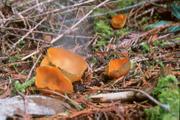
Andrew Parker |
- There are two species of Pithya in the Pacific Northwest which differ in size, habitat, and spore size.
Pithya cupressina (Fr.) Fuckel
CUP 0.1-0.5 cm wide, at first nearly spherical, becoming disc-shaped or elongated and irregular, flat or slightly concave; bright orange; exterior lighter in color than upper surface, smooth, white mycelial threads attach fruitbody to substrate. STEM if present, short and stout. HABIT and HABITAT gregarious on recently killed foliage of various species of Juniperus (juniper), Cupressus (cypress), Thuja (arbor-vitae), and Sequoia. DISTRIBUTION BC, WA, OR, ID. MICROSTRUCTURES spores 9-12 x 9-12 um, round, granular within and usually containing one large oil-droplet; asci reaching length of 310 um and width of 15 um; paraphyses branched in lower part, only slightly enlarged in upper part, reaching width of 2-4 um at tip.
Pithya vulgaris Fuckel
| CUP 0.1-1.5 cm wide, at first nearly spherical, becoming cushion-shaped to disc-shaped, flat to slightly convex; bright orange; exterior tinged with color of upper surface at margin and paler and whiter towards base with white anchoring hyphae. STEM short if present. HABITAT on wet, dead, usually detached branch tips (with needles) and twigs of Abies (fir), Sequoia, and Libocedrus (incense-cedar) in montane areas often close to snowbanks or within a few weeks of snow melting, March to May, also in fall. DISTRIBUTION BC, WA, OR, ID. MICROSTRUCTURES spores 12-14 x 12-14 um, round, colorless, without droplets (Seaver says at first granular within then with one large oil drop); asci to 300-331 um x 15 cm; paraphyses slightly enlarged in upper part, reaching width of 3-4 um at tip. | Pithya vulgaris
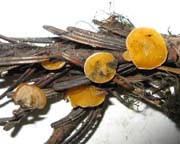
Michael Beug |
- See 23a.
- See 69a.
- Two species of Byssonectria occur in the Pacific Northwest: Byssonectria terrestris which occurs in confluent masses on the ground in spring, and Byssonectria cartilaginea which occurs in confluent masses on a thick mass of mycelium on rodent dung.
Byssonectria terrestris (Alb. & Schw.: Fr.) D. Pfister
| CUP 0.2-0.3 cm, somewhat cylindric to top-shaped, with bright orange spore-bearing surface concave or nearly flat, with delicate fringe-like border, exterior whitish or pale orange, seated on a conspicuous mycelial growth. HABIT and HABITAT gregarious or more often crowded together into confluent masses on the ground in early spring. DISTRIBUTION found in WA, elsewhere in North America. MICROSTRUCTURES spores 18.4-31.6 x 8-9.6 um, fusoid (spindle-shaped), colorless, containing two oil droplets, 1-seriate but often overlapping and partly 2-seriate; asci 8-spored, to 200-231 x 10-12 um; paraphyses rather strongly enlarged at tips. | Byssonectria terrestris
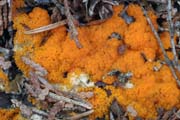
Andrew Parker |
Byssonectria cartilaginea (Kanouse & A.H. Sm.) D. Pfister
== Pseudocollema cartilagineum Kanouse & A.H. Sm.
| CUP 0.1 cm, spherical becoming somewhat top-shaped, soft and fleshy, produced on a thick cartilaginous stroma-like base formed over a dung heap (in the case of the type, the stroma 9-15 x 6-10 x 10 cm). HABIT and HABITAT densely gregarious on a thick tightly interwoven white to tan stroma on heap of rodent dung in spring as snow melting. DISTRIBUTION WA, AB, CA, elsewhere. MICROSTRUCTURES spores 20-24 x 8-9.6 um, elliptic, smooth, colorless, 1-seriate; asci 8-spored, 230-310 x 15-17 um; paraphyses slender, slightly enlarged in upper part. | Byssonectria cartilaginea
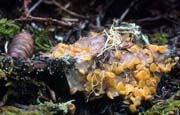
T O'Dell |
-
Aleuria aurantia (Pers. ex Hook.) Fuckel is a very common cup-fungus described in most field guides.
| FRUITBODY 1-10 cm wide, cup-shaped to saucer-shaped, soon expanding irregularly and flattening, often wavy and may be contorted; spore-bearing upper (inner) surface bright red-orange, smooth, outer surface lighter in color to pallid and smooth or finely downy; flesh thin and fragile. STEM none or rudimentary. HABIT and HABITAT growing singly or gregariously on soil or sand along roads and paths or freshly broken ground, less often in grass or moss. DISTRIBUTION BC, WA, OR, ID. MICROSTRUCTURES spores 18-24 x 9-12 um (Arora), (Bessette et al. give 17-24 x 9-11 um, Breitenbach et al. give 14-16 x 10 um not including ornamentation for Switzerland, Hansen et al. give 13-15 x 7.5-9 um for northern Europe.), elliptical, colorless, with coarsely reticulate (netted) ornamentation, sometimes with thorn-like processes on the ends, with two small oil droplets; asci 8-spored, 185-200 x 10-13 um; paraphyses septate, with orange granulation that turns green in iodine, slight clubshaped thickening at tip (microscopic description derived from Breitenbach et al.). | Aleuria aurantia
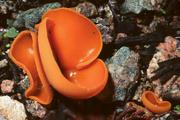
Sharon Godkin |
Aleuria rhenana is now called Sowerbyella rhenana (see 24a).
- See 24a.
- See 31b.
-
Miladina lechithina (Cooke) Svrcek
CUP 0.1-0.5 cm, convex cushion-shaped, or disc-shaped; yellow to orange, when dried deep orange to blackish, margin sometimes wavy. STEM without stem, on broad base, disc surrounded by whitish anchoring hyphae. HABIT and HABITAT gregarious or scattered, on decorticated wood (in many cases birch), in or under moving water or at least on water-soaked wood, (also on stones according to Seaver). DISTRIBUTION OR, ID, UT. MICROSTRUCTURES spores 18-24 x 8-14 um, elliptic, small sometimes anastomosing cyanophilic warts, colorless, thin-walled, 1-seriate, multiguttulate to spumose, when young with 1, 2, or 3 droplets and thick-walled; asci 8-spored, 200-275 x 13-20 um; paraphyses expanded at tip to 5-8 um, unbranching, containing orange-yellow granules which become green in iodine.
- See 79a.
- See Key to Pezizaceae, Pacific Northwest Key Council.
- See 31b.
- Larsen & Denison give Coprobia granulata (Fr.) Boud. for WA, OR, ID, CA, but now called Cheilymenia granulata (Bull.) J. Moravec and not found in Preliminary Checklist of North American Pezizales under either name.
- Four species of Pulvinula are known to occur in the Pacific Northwest. P. laeterubra is pale yellow and about 0.1 cm wide, with round spores. The other three are a shade of orange with round spores, but P. archeri has smaller spores than the other two. Pulvinula convexella is larger than Pulvinula carbonaria but otherwise the descriptions are not easy to distinguish and should be consulted in detail. P. constellatio (Berk. & Br.) Rehm is here regarded as a synonym of P. convexella.
Pulvinula archeri (Berk. in Hook.) Rifai
CUP up to 0.7 cm wide, convex with even margins, orange. STEM none. HABIT gregarious to scattered. DISTRIBUTION BC, WA, OR, ID. MICROSTRUCTURES spores 9-10.5 (11.5) um in diameter, round, smooth, generally with a single large oil droplet; asci 8-spored or fewer, 135-145 x 10-11 um; paraphyses slender, 1-2 um wide, circinate, mostly branched at top, pigment-filled.
Pulvinula carbonaria (Fuckel) Boud.
CUP 0.1-0.4 cm wide, at first spherical, becoming platter-shaped to disc-shaped, flat to slightly concave, pale orange, the outside a little paler than the spore-bearing surface, margin even or wavy. STEM none. HABIT and HABITAT gregarious or crowded on burned ground that has been overgrown with mosses. DISTRIBUTION at least OR, CA, MT. MICROSTRUCTURES spores up to 15-18 um in diameter, round, smooth, colorless, containing one oil droplet that almost fills the spore; asci reaching 231 x 18-20 um; paraphyses threadlike or slightly enlarged at tip, reaching 3-4 um wide at tip, strongly curved or hooked and extending far beyond the asci.
Pulvinula convexella (P. Karst.) Pfister
| CUP 0.3-1.2 cm wide, top-shaped to cushion-shaped to disc-shaped, orange to pink to scarlet, margin smooth and often strongly wavy, exterior lighter in color, to whitish pink. STEM none. HABIT and HABITAT single to gregarious or in clusters on bare sandy ground or burned ground or among mosses. DISTRIBUTION at least OR, AK, CA, CO, MT. MICROSTRUCTURES spores 13-18 um in diameter, round, smooth, colorless, with one or several droplets; asci 8-spored, 200-310 x 18 um; paraphyses slender, tips bent over like a cane and not thickened, not septate but forked. | Pulvinula convexella
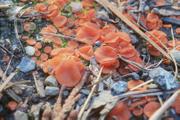
Andrew Parker |
Pulvinula laeterubra (Rehm) Pfister
CUP scarcely exceeding 0.1 cm, spherical becoming disc-shaped, pale yellow, exterior similar in color. STEM none. HABITAT on the ground and on burnt ground overrun by mosses. DISTRIBUTION at least BC, AB. MICROSTRUCTURES spores never exceeding 10 um in diameter and often smaller, round, smooth, colorless, granular inside but not containing conspicuous oil droplets, partly 2-seriate becoming 1-seriate; asci reaching 150-175 x 12-14 um; paraphyses threadlike, 1.5-2 um wide, slightly thickened in upper part and strongly curved at tip, sparingly branched, filled with colorless granules.
- 5 species of Lamprospora are included in the Preliminary Checklist of North American Pezizales, but it is not clear if any of these occur in the Pacific Northwest. Kanouse reported a number of Lamprospora species from the Pacific Northwest, and further investigation is warranted.
- See 31b.
- See 79a.
- See 69a.
- See 78b.
- See Key to Pezizaceae, Pacific Northwest Key Council
- See Key to Pezizaceae, Pacific Northwest Key Council
- Psilopezia nummularia Berk. is listed by Larsen & Denison for WA and ID, but the occurrence was not confirmed by either author and this species is not included in the Preliminary Checklist of North American Pezizales.
- See 29b.
- Fimaria species have been transferred to Pseudombrophila, and it is not clear which of these species occur in the Pacific Northwest.
- Pulparia planchonis occurs in WA according to the Larsen-Denison checklist, and the name has been changed to Smardaea planchonis (described below).
Smardaea planchonis (Dunal ex Boud.) R.P. Korf & W.-y. Zhuang
CUP reaching 0.5-0.8 cm wide, concave-hemispheric to disc-shaped, regular or irregularly contorted; dark purple; margin scalloped; exterior darker purple to almost black, minutely warted. STEM none. HABIT and HABITAT gregarious or scattered on sandy soil by roadsides, hillsides, and on sand-dunes. DISTRIBUTION at least WA. MICROSTRUCTURES spores up to 10-12 um, round, smooth or very minutely sculptured with warts that barely roughen the surface of the spore, colorless becoming pale purplish, containing one to several oil droplets, 1-seriate; asci reaching 200 x 13-15 um; paraphyses clavate, reaching 6 um wide at tip, filled with purple granules.
- See 34b.
- See Key to Helvellaceae, Pacific Northwest Key Council.
- See Key to Helvellaceae, Pacific Northwest Key Council.
- See Key to Helvellaceae, Pacific Northwest Key Council.
amyloid - staining bluish to gray to black in Melzer's reagent or IKI
apiculate - with an apiculus
apiculus - nipple-like projection on basidiospore which corresponds to the area that was attached to the sterigma of the basidium
apothecium - cup-like or saucer-like fruiting body in which the spore-bearing surface is exposed at maturity
ascomycete - fungus in which spores are released from an ascus
ascospore - spore produced by an ascomycete
ascus - cell in which ascospores (most often 8) are produced
aseptate - without septa
avellaneous - dull grayish brown, hazel-brown, or light gray yellow brown, or closer to drab, or gray tinged with pink, in Ridgway 1912 closer to pinkish buff
biguttulate - with 2 droplets
campanulate - bell-shaped
cartilaginous - of tissue, tough, like cartilage, not fibrous
cespitose - growing in tufts or close clusters from a common base, but not grown together
circinate - twisted round; coiled; curved or hooked at the apex like a shepherd's crook
clavate - club-shaped
cupulate - cup-shaped
cyanophilic - absorbing cotton blue
decorticated - of dead wood without the bark
dentate - toothed
dextrinoid - staining yellowish brown or reddish brown in Melzer's reagent
eccentrically - in an off-center manner
equal - of a stem, the same diameter throughout its length, cylindric
excipulum - tissues containing the hymenium (spore-bearing surface) in an apothecium
filiform - threadlike, long and slender
flexuous - bent alternately in opposite directions
floccose - with easily removed cottony or woolly tufts; woolly or cottony; dry and loosely arranged; having the appearance of cotton flannel; with a soft cottony texture
furfuraceous - scurfy, surface covered with branlike particles resembling scales, coarser than granular
fusiform - spindle-shaped, fairly slender and narrowing from middle to both ends
fusoid - somewhat spindle-shaped, almost spindle-shaped or fusiform
glaucous - sea-gray; sea-blue-green; covered with white bloom
guttulate - of spores, containing an oil droplet or oil droplets
hyaline - colorless
hymenium - fertile area of fruiting body where spores are produced
IKI - iodine potassium iodide - see Appendix
inamyloid - remaining clear or becoming yellow in Melzer's reagent, not amyloid or dextrinoid, same as nonamyloid
KOH - potassium hydroxide, an agent commonly used to revive dried mushroom material, or show chemical reactions on the surface of the mushroom, or chemical reactions under the microscope
multiguttulate - with many droplets
pruinose - looking finely powdered or finely granular
pseudorhiza - a long rootlike extension of the lower stem
reflexed - turned up or back
reticulate - covered with a network of interlacing lines, ridges, or folds
reticulum - a network of interlacing lines, ridges, or folds
sensu - in the sense of
septate - partitioned with cross-walls
-seriate - refers to arrangement of spores in ascus: 2-seriate means they are arranged in twos, 1-seriate means they are in single file
sessile - lacking a stem
seta - bristle-like hair
sparassoid – with interlaced fan-shaped branches forming structures suggesting Sparassis
spumose - foamy
stellate - star-shaped
stipitate - having a stipe (or stem)
stroma - a mass of vegetative hyphae
sub- - somewhat, nearly, more or less; under
subiculum - a net-, wool-, or crust-like growth of mycelium under fruiting bodies
substrate - the material that a fungus is growing on
tomentose - covered with soft hairs, often soft densely matted hairs, like a woollen blanket
truncate - larger portion ending as if cut off, having the end square
Staining Reagents:
Aceto-carmine Stain. (modified from Johansen, 1940)
| carmine stain | 0.5 g |
| +boiling 45% acetic acid | 100 ml |
| +iron nail or aqueous Ferric hydrate solution | |
- Carefully add carmine to boiling acetic acid (it will boil up quickly at this point), remove from heat, cool, and decant or filter.
- Add iron either by a) placing iron nail in the solution for a few minutes (until solution becomes appreciably darker in color) and then remove it or b) add Ferric hydrate dropwise to one half of stain until it becomes bluish-red, then dilute 50:50 with unmodified stain.
Cotton Blue in lactic acid or lactophenol
| Cotton Blue (Aniline Blue) | 0.05 g |
| Lactic acid (or lactophenol) | 30 ml |
- Allow dye to dissolve slowly without heating. After several days, filter to remove precipitates.
- Use by mounting material in a drop of stain, add coverslip, and heat gently to just boiling.
- Cyanophilic spore sculpturing stains dark blue.
IKI Staining Solutions
Melzer's Reagent:
| Chloral Hydrate | 44 g *restricted chemical |
| Distilled water | 40 ml |
| Potassium Iodide (KI) | 3.0 g |
| Iodine (I) | 1.0 g |
IKI in lactophenol: (more readily available)
Lactophenol
| Phenol | 20 g or 20 ml melted crystals |
| Lactic acid | 20 g or 20 ml |
| Glycerine | 40 g or 40 ml |
| Distilled water | 20 g or 20 ml |
| Lactophenol (see above) | 40 ml |
| Potassium Iodide (KI) | 1.5 g |
| Iodine (I) | 0.5 g |
The staining reaction of solutions a & b are very comparable (almost indistinguishably so).
Processing of specimens
Record the following data about the specimen:
- Where collected (be as specific as possible)
- Habitat and substrate
- Date collected
- Name of collector
- General description of specimen (size, shape, color of hymenium and exterior, etc.)
slides, photos, etc. are frequently helpful if taken of fresh specimens
- Air dry specimen (open brown paper bag works fine).
- Mail or take to specialist (with data).
- Arora, David. 1986 Mushrooms Demystified Second Edition. Ten Speed Press, Berkeley.
- Bezerra, J.L., J.W. Kimbrough. 1975. "The genus Lasiobolus." Can. J. Bot. 53: 1206-1229.
- Breitenbach, J., Kränzlin, F. 1984. Fungi of Switzerland Volume 1 Ascomycetes. Edition Mykologia Lucerne.
- Brummelen, J. Van. 1967. "A world-monograph of the genera Ascobolus and Saccobolus." Persoonia Suppl. Vol. I.
- Cain, Roy F., J.W. Kimbrough. 1966. "Coprobolus, a new genus of the tribe Theleboleae (Pezizaceae)." Can. J. Bot. 47:1911-1914.
- Castellano, M., Jane E. Smith, Thom O'Dell, Efren Cazares, Susan Nugent. 1999. Handbook to Strategy 1 Fungal Species in the Northwest Forest Plan. General Technical Report PNW-GTR-476. United States Department of Agriculture.
- Courtecuisse, R., Duhem, B. 1995. Mushrooms and Toadstools of Britain & Europe. Collins Field Guide. Harper Collins, London.
- Denison, William C. 1959. "Some Species of the genus Scutellinia." Mycologia 51: 605-635.
- Denison, William C. 1964. "The genus Cheilymenia in North America." Mycologia 56: 718-737.
- Dennis, R.W.G. 1978. British Ascomycetes. J. Cramer. Vaduz. 585pp.
- Ginns, J. 1975. Caloscypha fulgens. Fungi Canadenses No. 66. Agriculture Canada.
- Hansen, Lise, Henning Knudsen editors. 1992. Nordic Macromycetes. Volume 1. Ascomycetes Nordsvamp, Copenhagen.
- Harrington, Francis A. 1990. "Sarcoscypha in North America (Pezizales, Sarcoscyphaceae)." Mycotaxon 38: 417-458.
- Kanouse, Bessie B., A.H. Smith. 1940. "Two New Genera of Discomycetes from the Olympic National Forest. " Mycologia 32: 756-759.
- Kanouse, Bessie B. 1947. "A survey of the Discomycete Flora of the Olympic National Park and Adjacent Areas." Mycologia 39: 635-689.
- Kanouse, Bessie B. 1949. "Studies in the genus Otidea." Mycologia 41: 660-677.
- Kanouse, Bessie B. 1958. "Some species of the genus Trichophaea." Mycologia 50: 121-139.
- Kimbrough, James W. 1966. "The structure and development of Trichobolus zukalii." Mycologia 58: 289-306.
- Kimbrough, James W. 1969. "North American species of Thecotheus (Pezizeae, Pezizaceae)." Mycologia 61: 99-114.
- Kimbrough, James W., E. R. Luck-Allen, Roy F. Cain. 1971. "North American Species of Coprotus (Thelebolaceae: Pezizales)." Can. J. Bot. 50: 957-971.
- Larsen, Jr., Harold J., William Denison. 1978. "A checklist of the operculate cup-fungi (Pezizales) of North America west of the Great Plains." Mycotaxon 7(1): 68-90.
- Lincoff, Gary. 1981. Simon and Shuster’s Guide to Mushrooms. Simon & Shuster, New York.
- Lincoff, Gary. 1995. National Audubon Society Field Guide to North American Mushrooms. Knopf, New York.
- McKnight, Kent H., McKnight, Vera B. 1987. A Field Guide to Mushrooms North America. Peterson Field Guide Series. Houghton Mifflin, New York.
- Moravec, Jiri. 1990. "Taxonomic Revision of the genus Cheilymenia - 3. A new generic and infrageneric classification of Cheilymenia in a new emendation." Mycotaxon 38: 459-484.
- Pfister, Donald H. 1976. "A synopsis of the genus Pulvinula." Occasional papers of the Farlow Herbarium of Harvard University. No. 9: 1-19.
- Pfister, Donald H., Richard P. Korf. 1981. "The psilopezioid fungi. V. Miladina lechithina." Can. J. Bot. 52: 1643-1645.
- Pfister, Donald H. 1982. "A Nomenclatural Revision of F.J. Seaver's North American Cup-Fungi (Operculates)." Occasional Papers of the Farlow Herbarium of cryptogamic botany 17.
- Pfister, Donald H. 1993. "A synopsis of the North American species of Byssonectria (Pezizales) with comments on the ontogeny of two species." Mycologia. 85(6): 952-962.
- Phillips, Roger. 1991. Mushrooms of North America. Little, Brown, & Co., Boston.
- Redhead, S.A. 1997. Macrofungi of British Columbia: Requirements for Inventory. Ministry of Forests of British Columbia.
- Seaver, Fred Jay. 1942. The North American Cup-Fungi (Operculates). Supplemented Edition. Hafner Publishing Company. New York.
- Weber, N.S., J.M. Trappe, W.C. Denison. Preliminary Checklist of the Pezizales in Western North America. http://www.bcc.orst.edu/mycology/pezweb. Accessed 2001. No longer online.
| GENUS AND SPECIES |
KEY ENTRIES |
FOOTNOTES |
| |
|
| ALEURIA Fuckel |
79a, 83a, 89a |
|
| A. aurantia (Pers. ex Hook.) Fuckel |
79a |
78 |
| |
|
| ANTHRACOBIA Boud. |
55a, 59b |
|
| A. macrocystis (Cooke) Boud. |
55a |
57 |
| A. melaloma (Alb. & Schw. ex Fr.) Boud. |
55a |
57 |
| |
|
| ASCOBOLUS Pers. |
63a, 66a |
|
| A. carbonarius Karst. |
63a |
62 |
| A. foliicola Berk. & Br. |
63a |
62 |
| A. furfuraceus Pers. ex Pers. |
63a |
62 |
| A. geophilus Seaver |
63a |
62 |
| A. immersus Pers. ex Pers. |
63a |
62 |
| A. lignatilis Alb. & Schw. ex Pers. |
63a |
62 |
| A. michaudii Boud. |
63a |
62 |
| A. sacchariferus Brumm. |
63a |
62 |
| |
|
| BARLAEINA Sacc. & P. Syd. |
97a |
|
| |
|
| BOUDIERA Cooke |
64a |
|
| |
|
| BYSSONECTRIA P. Karst. |
42a, 78b, 90b |
|
| B. cartilaginea (Kanouse A.H. Sm.) D. Pfister |
78b |
77 |
| == Pseudocollema cartilagineum Kanouse & A.H. Sm. |
|
|
| B. terrestris (Alb. & Schw.: Fr.) D. Pfister |
78b |
77 |
| == Thelebolus terrestris Alb. & Schw. |
|
|
| |
|
| CALOSCYPHA Boud. |
74a |
|
| C. fulgens (Pers.) Boud. |
74a |
73 |
| |
|
| CHEILYMENIA Boud. |
54b |
|
| C. crucipila (See Scutellinia crucipila.) |
|
|
| C. coprinaria (Cooke) Boud. |
54b |
56 |
| C. fimicola (De Not. & Bagl.) Dennis |
54b |
56 |
| C. granulata (Bull.) J. Moravec |
54b |
56 |
| == Coprobia granulata (Fr.) Boud. |
|
|
| C. stercorea (Pers. ex Fr.) Boud. |
54b |
56 |
| == Scutellinia stercorea (Pers. ex Fr.) Kuntze |
|
|
| == Patella stercorea (Pers. ex Fr.) Seaver |
|
|
| C. theleboloides (Alb. & Schw. ex Fr.) Boud. |
54b |
56 |
| == Scutellinia theleboloides (Alb. & Schw. ex Fr.) Kuntze |
|
|
| |
|
| COPROBIA Boud. (absorbed into CHEILYMENIA) |
85a |
|
| C. granulata (See Cheilymenia granulata.) |
|
|
| |
|
| COPROTUS Korf & Kimbr. |
70a |
|
| C. glaucellus (Rehm) Kimbr. |
70a |
70 |
| C. granuliformis (Crouan & H. Crouan) Kimbr. |
70a |
70 |
| C. luteus Kimbrough, Luck & Cain |
70a |
70 |
| C. ochraceus (Crouan & H. Crouan) Larsen |
70a |
70 |
| |
|
| DESMAZIERELLA Lib. |
49a |
|
| D. acicola Lib. |
49a |
50 |
| |
|
| DISCINA (Fr.) Fr. |
34a, 100a |
36 |
| |
|
| DISCIOTIS Boud. |
34b, 98a |
|
| D. venosa (Pers. ex Fr.) Boud. |
34b, 98a |
37 |
| |
|
| FIMARIA Velen. (absorbed into PSEUDOMBROPHILA) |
96a |
96 |
| |
|
| GEOPORA Harkn. |
6a, 45a |
|
| G. cooperi Harkn. |
6a |
4 |
| |
|
| GEOPYXIS (Pers.) Sacc. |
25a |
|
| G. carbonaria (Alb. & Schw. ex Pers.) Sacc. |
25a |
24 |
| G. vulcanalis (Peck) Sacc. |
25a |
24 |
| |
|
| GYROMITRA Fr. |
11a, 14a |
12 |
| G. gigas (Krombh.) Qué |
11a |
|
| G. melaleucoides (Seaver) Pfister |
100b |
101 |
| |
|
| HELVELLA L. |
14b, 33a, 99a |
13 |
| |
|
| HIEMSIA Svrcek |
56a |
|
| |
|
| HUMARIA Fuckel |
7a, 51a |
|
| H. hemisphaerica (Wigg. ex Fr.) Fuckel |
7a |
5 |
| |
|
| JAFNEA Korf |
31a, 58a |
|
| |
|
| LAMPROSPORA De Not. |
87b |
87 |
| |
|
| LASIOBOLUS Sacc. |
68a |
67 |
| L. cuniculi Vel. |
68a |
67 |
| L. intermedius J.L. Bezerra & Kimbr. |
68a |
67 |
| L. lasioboloides March. |
68a |
67 |
| L. macrotrichus Rea |
68a |
67 |
| L. papillatus (Pers.: Fr.) Sacc. |
68a |
67 |
| L. ruber (Quél.) Sacc. |
68a |
67 |
| |
|
| LEUCOSCYPHA Boud. |
23a, 77a |
22 |
| |
|
| MARCELLEINA Brumm., Korf & Rifai |
97a |
|
| |
|
| MELASTIZA Boud. |
56b |
|
| M. chateri (W.G. Smith) Boud. |
56b |
58 |
| |
|
| MICROSTOMA Bernstein |
22a |
|
| M. protractum (Fr.) Kanouse |
22a |
20 |
| |
|
| MILADINA Svrcek |
81a |
|
| M. lechithina (Cooke) Svrcek |
81a |
81 |
| |
|
| MORCHELLA Dill. ex Pers. |
9a |
7 |
| |
|
| NANNFELDTIELLA Eckblad (absorbed into Pseudombrophila) |
42a |
44 |
| N. aggregata Eckblad |
42a |
44 |
| |
|
| NEOTTIELLA (Cooke) Sacc. |
23a, 77a |
|
| N. hetieri Boud. |
23a |
22 |
| == Leucoscypha hetieri (Boud.) Rifai |
|
|
| N. rutilans (Fr.: Fr.) Dennis |
23a |
22 |
| == Leucoscypha rutilans (Fr.) Dennis & Rifai |
|
|
| |
|
| NEOURNULA Paden & Tylutki |
2a, 44a |
|
| N. pouchetii (Berthet & Riousset) Paden |
2a, 44a |
1 |
| |
|
| OCTOSPORA Hedw. |
69a, 78a, 90a |
69 |
| O. leucoloma Hedw. ex S.F. Gray |
69a |
69 |
| O. rubens (Boud.) Moser |
69a |
69 |
| |
|
| OTIDEA (Pers.) Bonord. |
29b, 72a, 95a |
31 |
| O. alutacea (Pers.) Massee |
29b |
31 |
| O. bufonia (Pers.) Boud. |
29b |
31 |
| O. cantharella var. minor Boud. |
29b |
31 |
| O. concinna (Pers.) Sacc. |
29b |
31 |
| O. grandis (Pers.) Rehm |
29b |
31 |
| O. leporina (Fr.) Fuckel |
29b |
31 |
| O. onotica (Pers.) Fuckel |
29b |
31 |
| O. ranierensis Kanouse |
29b |
31 |
| O. smithii Kanouse |
29b |
31 |
| |
|
| PACHYELLA Boud. |
93a |
92 |
| |
|
| PARATRICHOPHAEA Trigaux |
50a |
51 |
| P. boudieri (Grélet) Bronckers |
50a |
51 |
| |
|
| PEZIZA Fr. |
32a, 41a, 84a, 93b |
34 |
| P. ammophila Durieu & Montagne |
4a |
2 |
| |
|
| PITHYA Fuckel |
74b |
74 |
| P. cupressina (Fr.) Fuckel |
74b |
74 |
| P. vulgaris Fuckel |
74b |
74 |
| |
|
| PLECTANIA Fuckel |
18a, 43b |
16 |
| |
|
| PLICARIA Fuckel |
32a |
|
| |
|
| PSEUDOCOLLEMA Kanouse & A.H. Sm. (absorbed into Byssonectria) |
37a |
39 |
| P. cartilagineum (See Byssonectria cartilaginea.) |
|
|
| |
|
| PSEUDOMBROPHILA Boud. |
27b, 59a |
|
| P. aggregata (Eckblad) Harmaja |
42a |
|
| P. deerata (Karst.) Seaver |
27b, 59a |
29 |
| |
|
| PSEUDOPITHYELLA Seaver |
21a |
|
| P. minuscula (Boud. & Torrend) Seaver |
21a |
19 |
| == Sarcoscypha minuscula Boud. & Torrend |
|
|
| |
|
| PSEUDOPLECTANIA Fuckel |
18b, 43a |
17 |
| |
|
| PSILOPEZIA Berk. |
94a |
|
| P. nummularia Berk. |
94a |
94 |
| |
|
| PULPARIA P. Karst. (nom. rej. = PULVINULA) |
97a |
|
| P. planchonis (See Smardaea planchonis.) |
|
|
| |
|
| PULVINULA Boud. |
87a |
86 |
| P. archeri (Berk. in Hook.) Rifai |
87a |
86 |
| P. carbonaria (Fuckel) Boud. |
87a |
86 |
| P. convexella (Karst.) Pfister |
87a |
86 |
| = Pulvinula constellatio (Berk. & Br.) Rehm |
|
|
| P. laeterubra (Rehm) Pfister |
87a |
86 |
| |
|
| PUSTULARIA Fuckel |
31b, 80b |
|
| |
|
| PYRONEMA Carus |
37b |
|
| P. omphalodes (Bull. ex St.-Amans) Fuckel |
37b |
40 |
| P. domesticum (Sowerby) Sacc. |
37b |
40 |
| |
|
| RHIZINA Fr. |
35a |
|
| R. undulata Fr. |
35a |
38 |
| = Rhizina inflata (Schaeffer) P. Karst. |
|
|
| |
|
| SACCOBOLUS Boud. |
63b |
|
| S. depauperatus (Berk. & Br.) Hansen |
63b |
63 |
| S. versicolor (Karst.) Karst. |
63b |
63 |
| |
|
| SARCOSCYPHA (Fr.) Boud. |
22b |
|
| S. coccinea (Jacq. ex Gray) Lambotte |
22b |
21 |
| |
|
| SARCOSOMA Casp. |
17a, 39a |
15 |
| |
|
| SARCOSPHAERA Auersw. |
4b |
|
| S. crassa (Santi ex Steudl) Pouzar |
4b |
3 |
| == S. coronaria (Jacq. ex Cooke) Boud. |
|
|
| |
|
| SCUTELLINIA (Cooke) Lambotte |
54a |
55 |
| S. crucipila (Cooke et Phill. in Cooke) J. Moravec |
54a |
55 |
| == Cheilymenia crucipila (Cooke & Phillips) LeGal |
|
|
| = Humaria stellata Kanouse |
|
|
| S. erinaceus (Schw.) Kuntze |
54a |
55 |
| = Patella setosa sensu Seaver |
|
|
| S. scutellata (L. ex Fr.) Lambotte |
54a |
55 |
| = Patella lusatiae (Cooke) Seaver |
|
|
| S. umbrarum (Fr.) Lambotte |
54a |
55 |
| == Patella umbrorum (Fr.) Seaver |
|
|
| S. verrucipolaris Denison |
54a |
55 |
| |
|
| SEPULTARIA (absorbed into GEOPORA) |
6a, 45a |
|
| |
|
| SMARDAEA Svrcek |
97a |
|
| S. planchonis (Dunal ex Boud.) R.P. Korf & W.-y. Zhuang |
97a |
97 |
| == Plicaria planchonis Dunal ex Boud. |
|
|
| == Lamprospora planchonis (Dunal ex Boud.) Seaver |
|
|
| == Pulparia planchonis (Dunal ex Boud.) Korf, Pfister & Rogers |
|
|
| |
|
| SOWERBYELLA Nannf. |
24a, 80a |
|
| S. rhenana (Fuckel) J. Moravec |
24a |
23 |
| == Aleuria rhenana Fuckel |
|
|
| |
|
| SPHAEROSOMA Klotzsch |
92a |
|
| |
|
| SPHAEROSPORELLA (Svrcek) Svrcek & Kubicka |
57a |
|
| |
|
| TARZETTA (Cooke) Lambotte |
31b, 80b, 84b, 88a |
25 |
| T. catinus (Holmsk.: Fr.) Korf & J.K. Rogers |
24a |
25 |
| T. cupularis (L. ex Fr.) Lambotte |
24a |
25 |
| |
|
| THECOTHEUS Boud. |
65b |
65 |
| T. agranulosus Kimbr. |
65b |
65 |
| T. apiculatus Kimbr. |
65b |
65 |
| T. cinereus (Crouan & H. Crouan) Chenantais |
65b |
65 |
| T. crustaceus (Starbäck) Aas & N. Lundq. |
65b |
65 |
| T. keithii (W. Phillips) Aas |
65b |
65 |
| T. pelletieri (Crouan) Boud. |
65b |
65 |
| |
|
| THELEBOLUS Tode |
70b |
71 |
| T. stercorius (Pers.) Fr. |
70b |
71 |
| |
|
| TRICHARINA Eckblad |
7b, 50b, 51b |
6 |
| T. gilva (Boud.) Eckblad |
7b |
6 |
| |
|
| TRICHOBOLUS (Sacc.) Kimbr. & Cain |
68b |
68 |
| T. zukalii (Heimerl) Kimbr. & Korf |
68b |
68 |
| |
|
| TRICHOPHAEA Boud. |
50a, 57a |
51 |
| T. abundans (Karst.) Boud. |
50a |
51 |
| == Patella abundans Seaver |
|
|
| T. boudieri Grélet |
50a |
51 |
| T. bullata Kanouse |
50a |
51 |
| T. gregaria (Rehm) Boud. |
50a |
51 |
| T. hemisphaerioides (Mont.) Graddon |
50a |
51 |
| |
|
| URNULA Fr. |
16a, 40a |
14 |
| |
|
| VERPA Sw. |
10a |
8 |
| |
|
| WYNNELLA Boud. |
29a |
|
| W. silvicola (Beck) Nannf. |
29a |
30 |
| == Helvella silvicola (Beck) Harmaja |
|
|
| == Otidea silvicola Beck |
|
|
| = Otidea auricula (Cke.) Mass. |
|
|
- END -

.jpg)
.jpg)




















